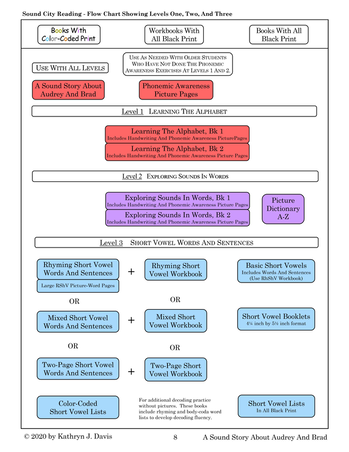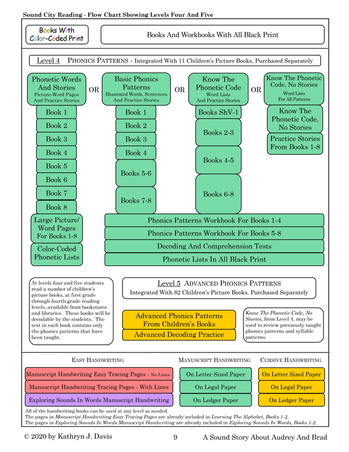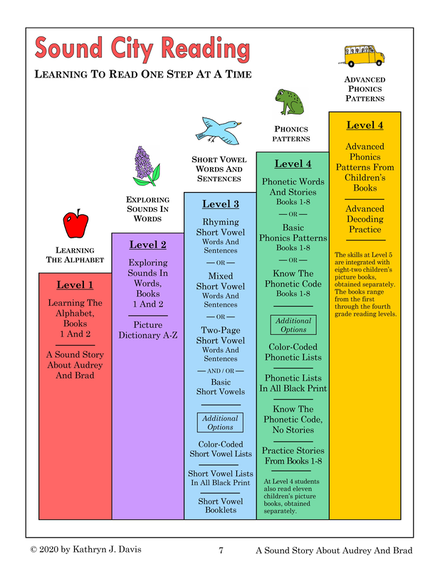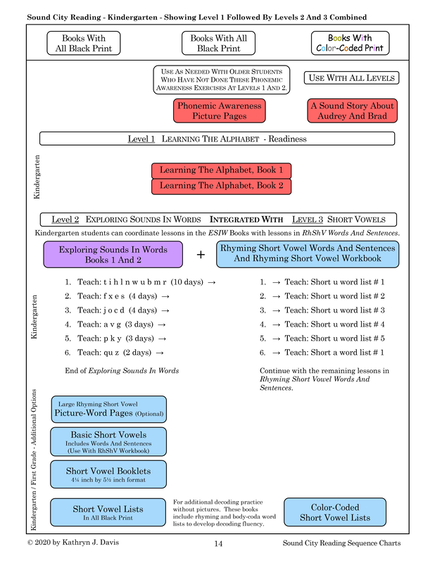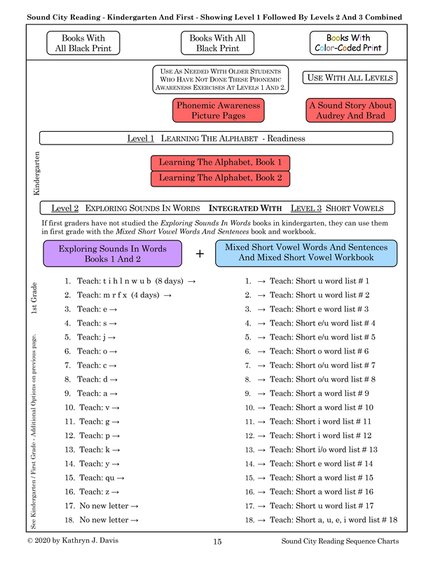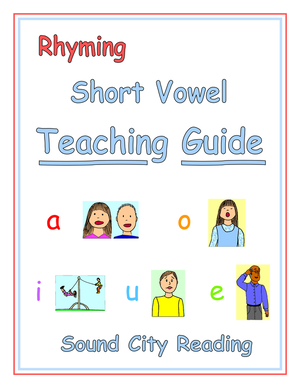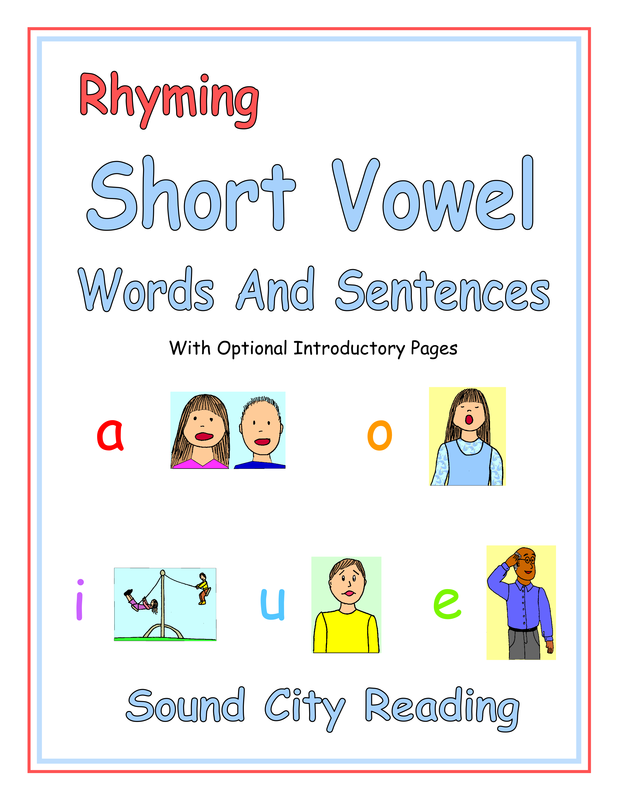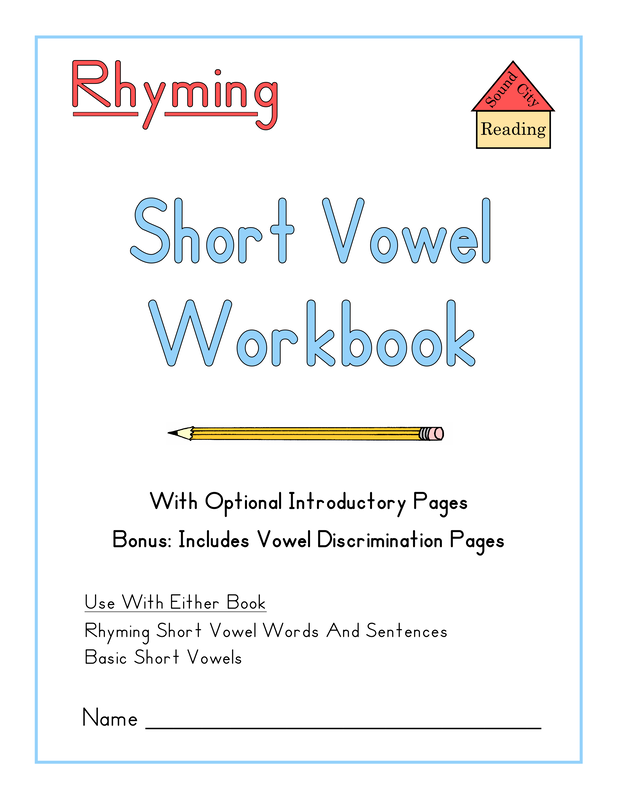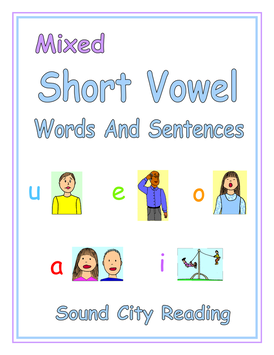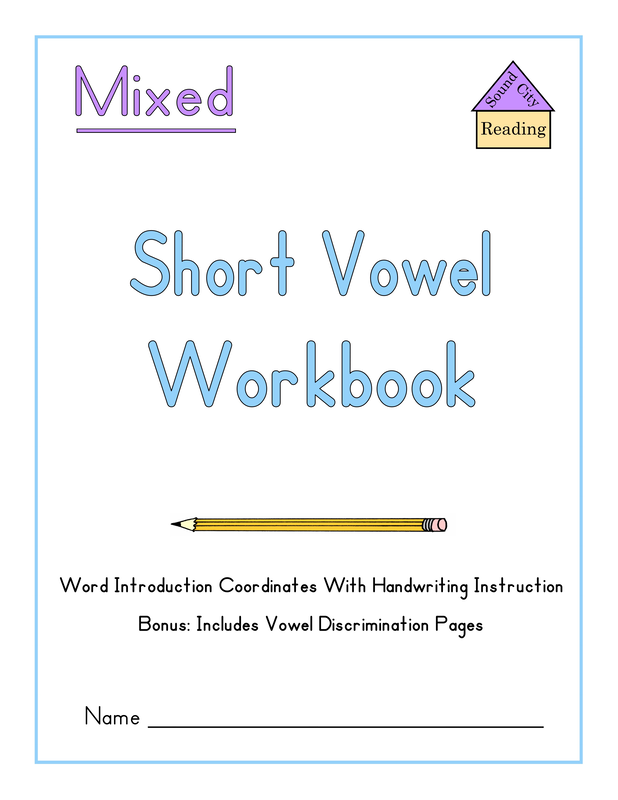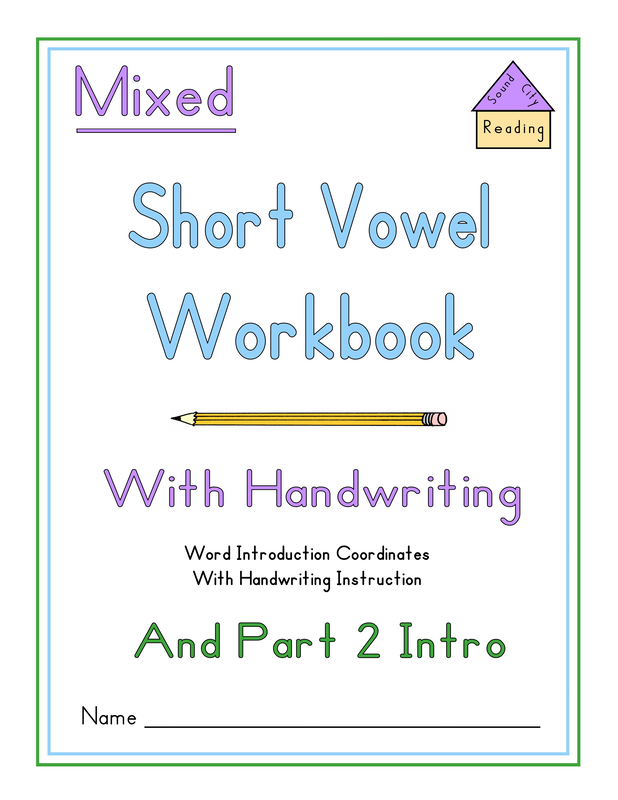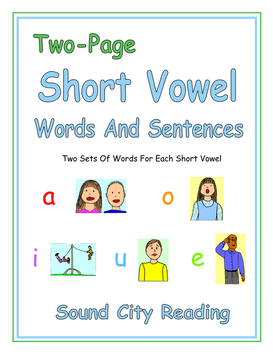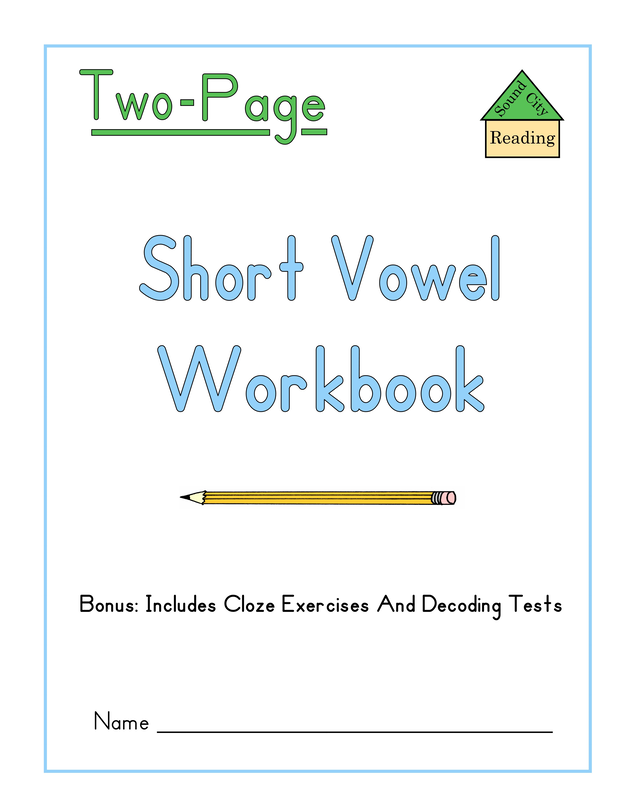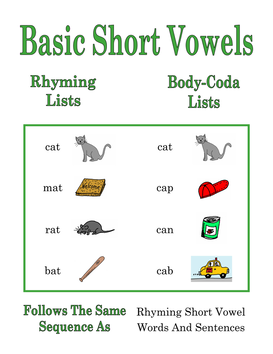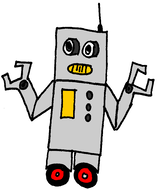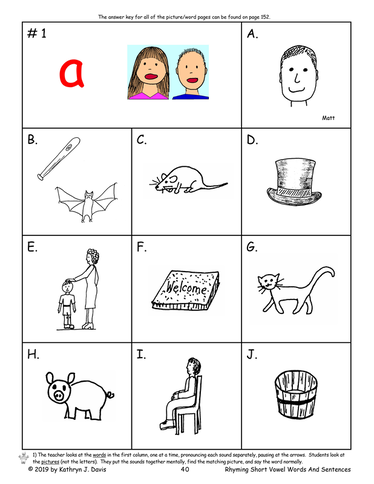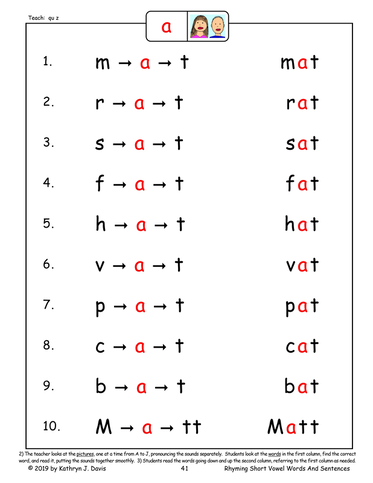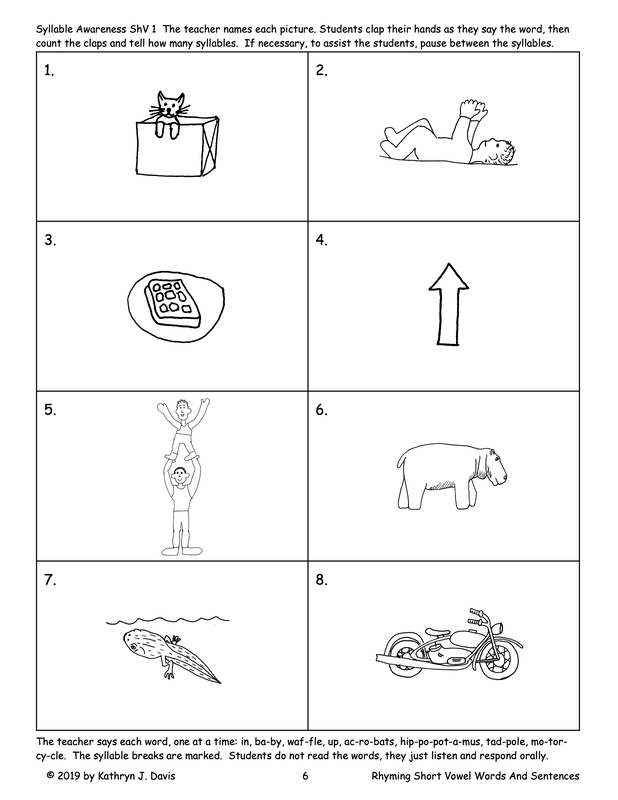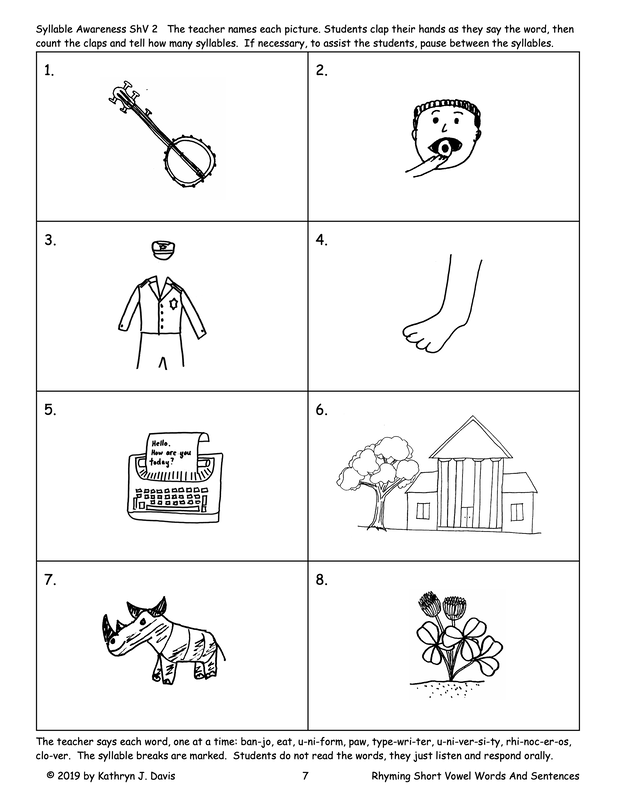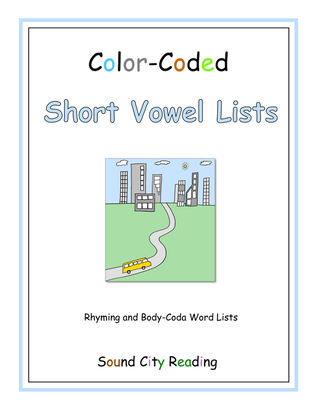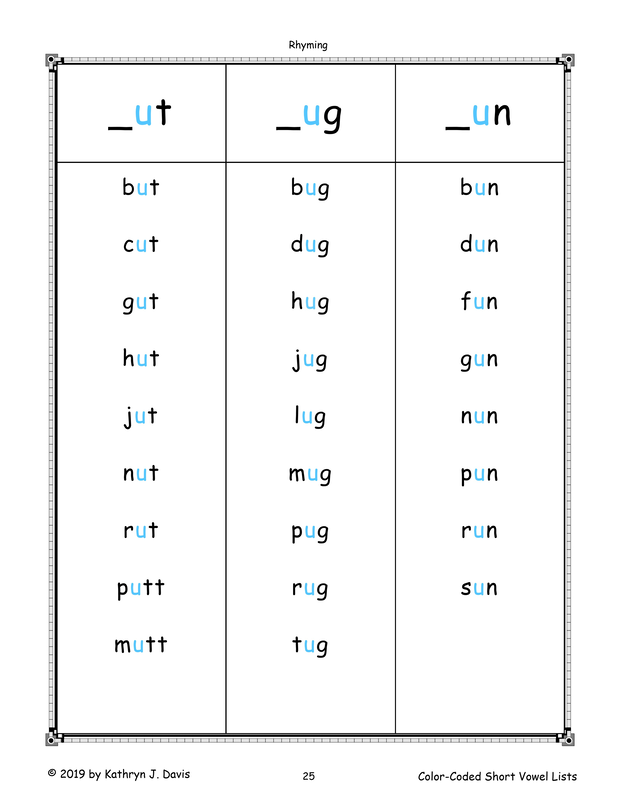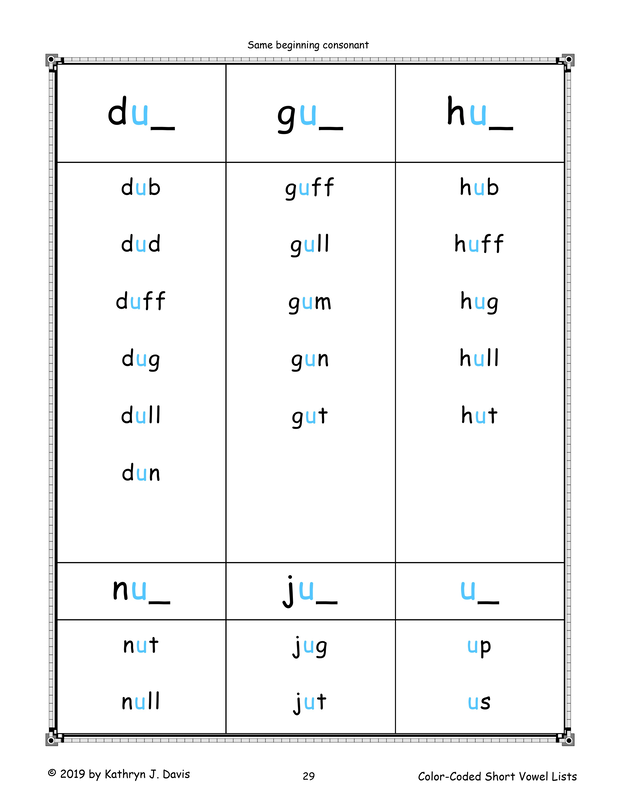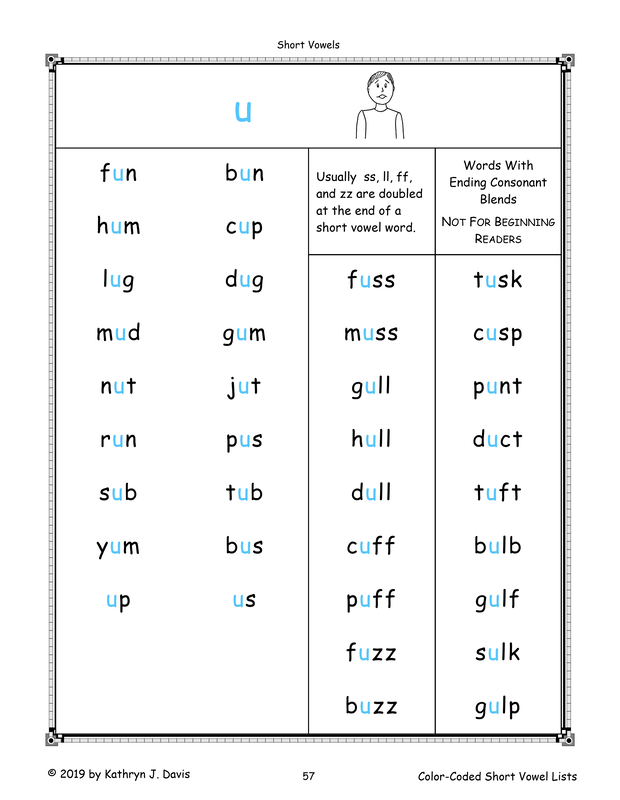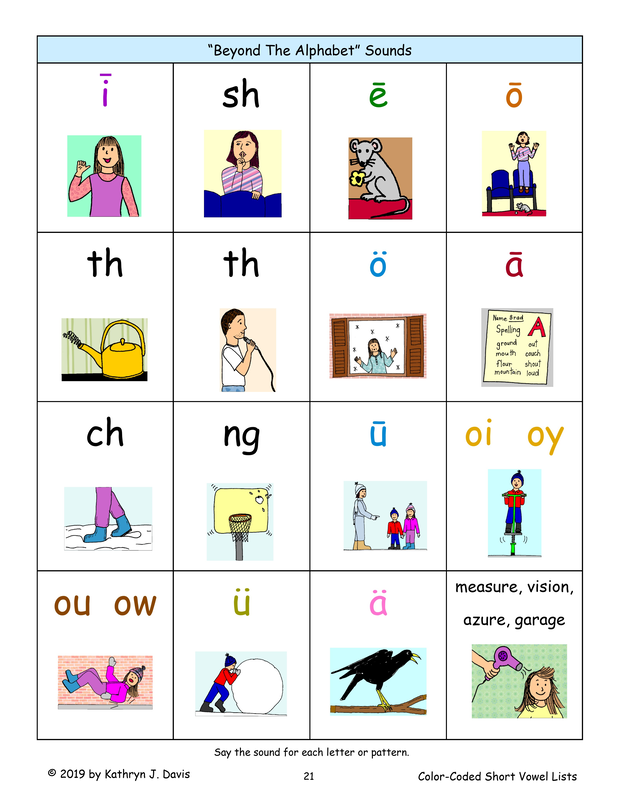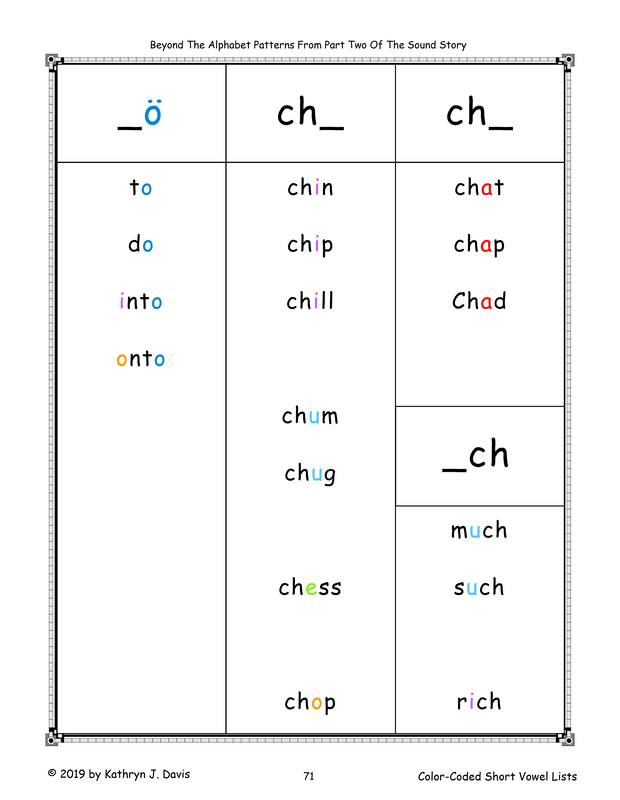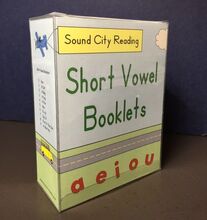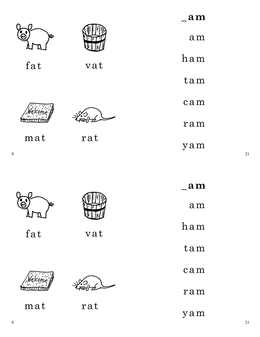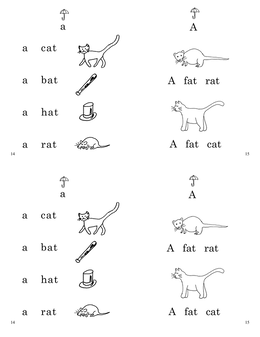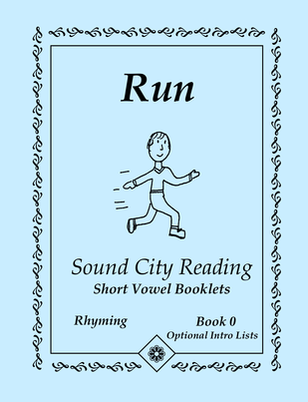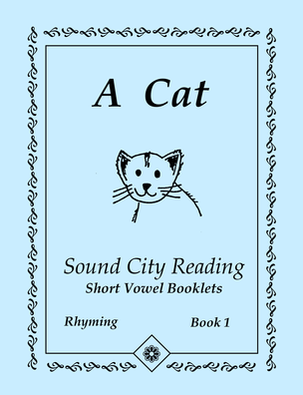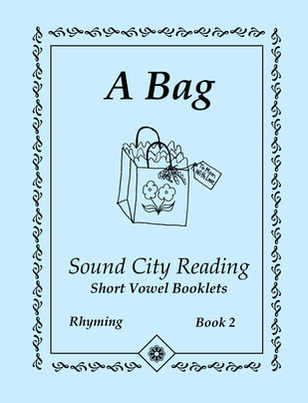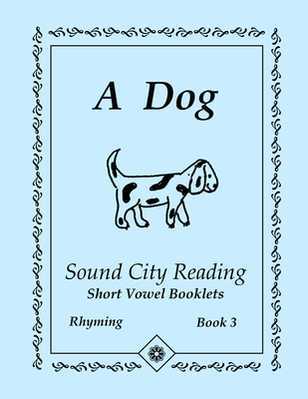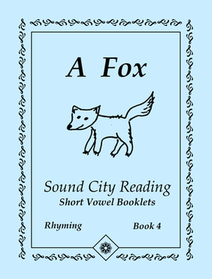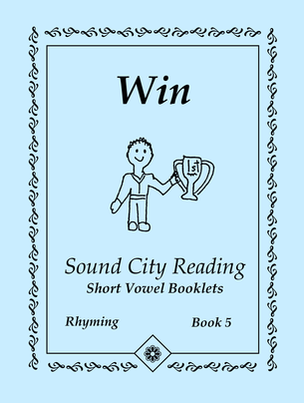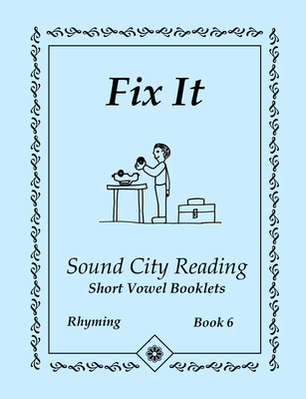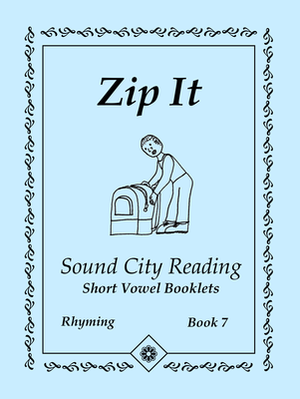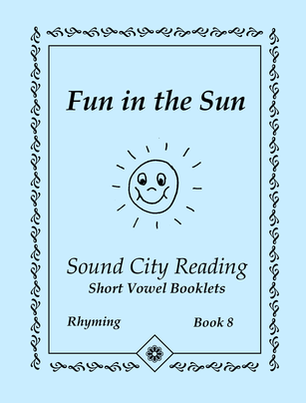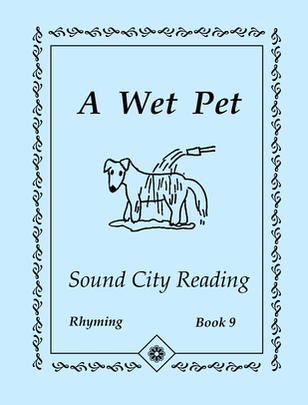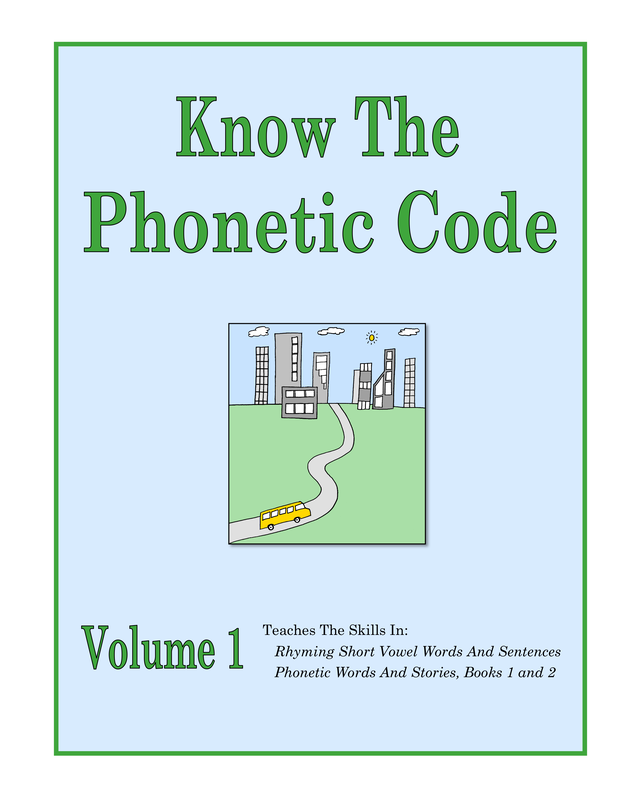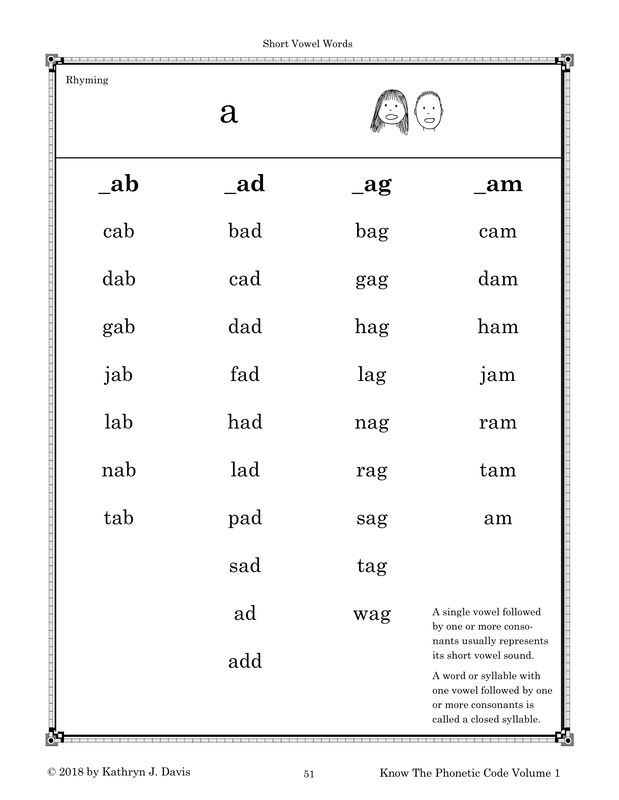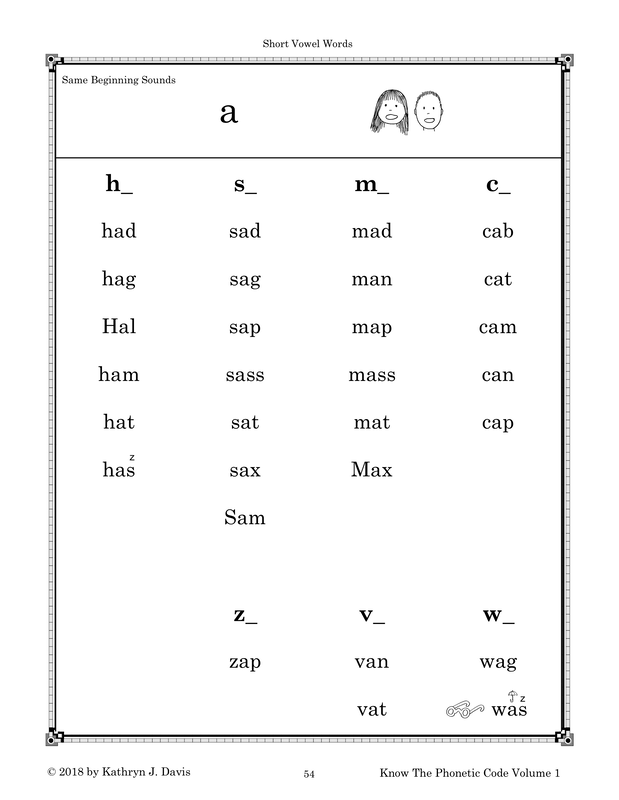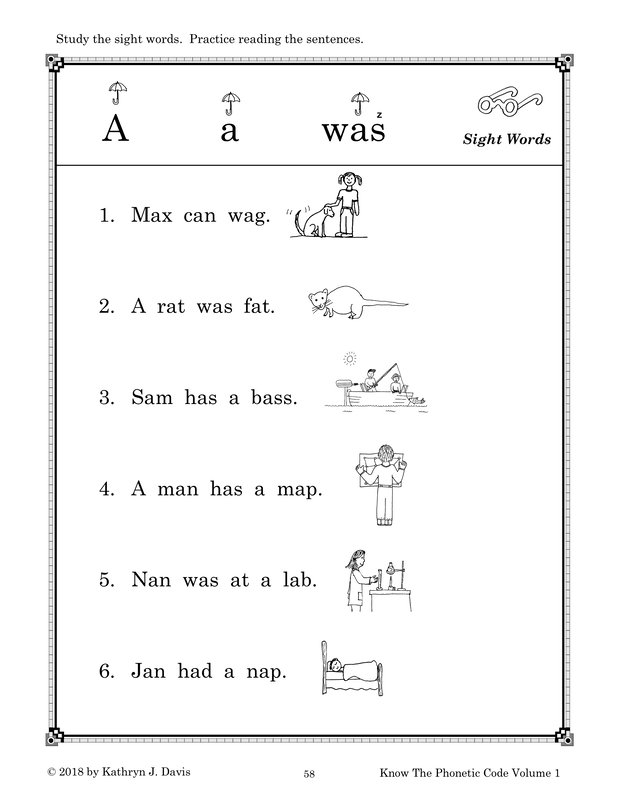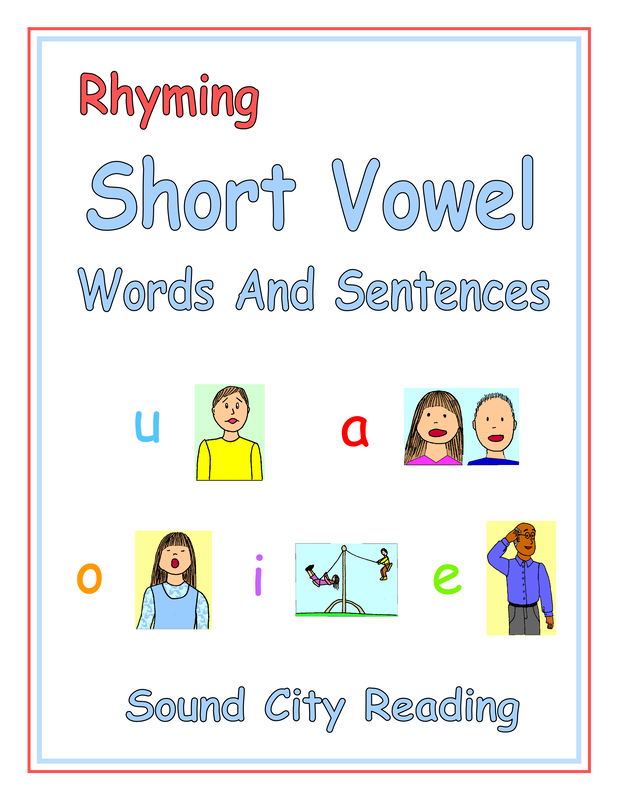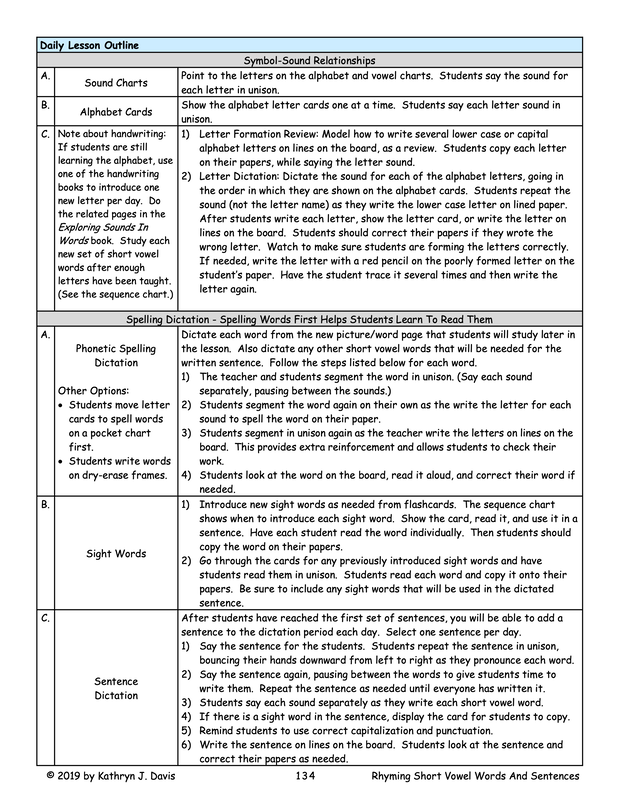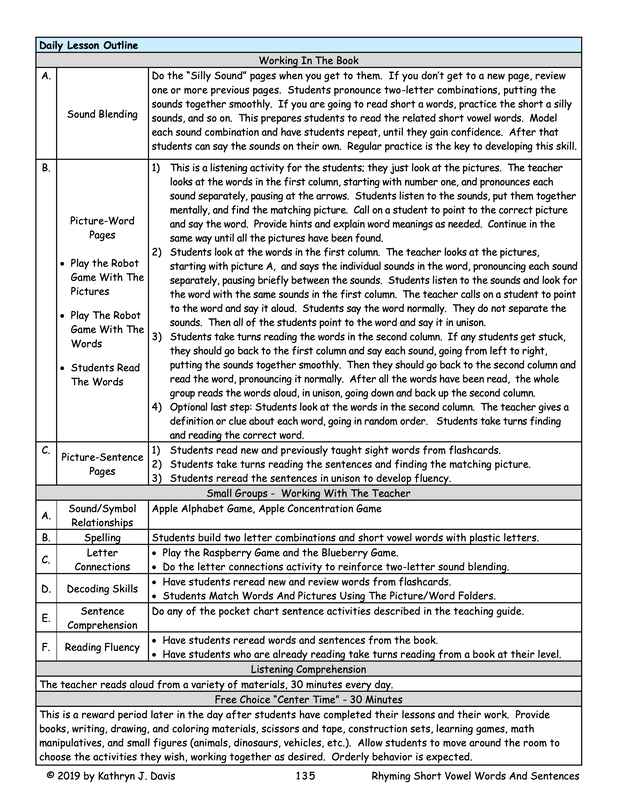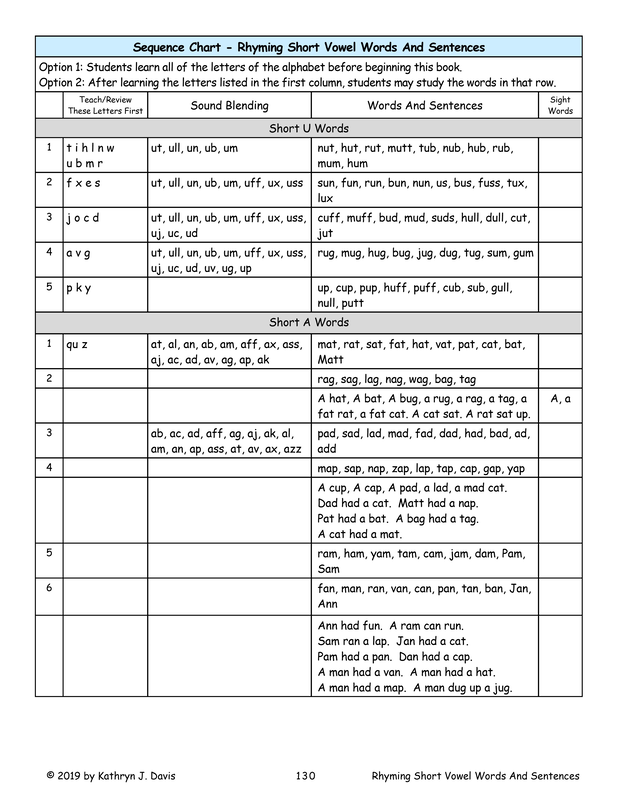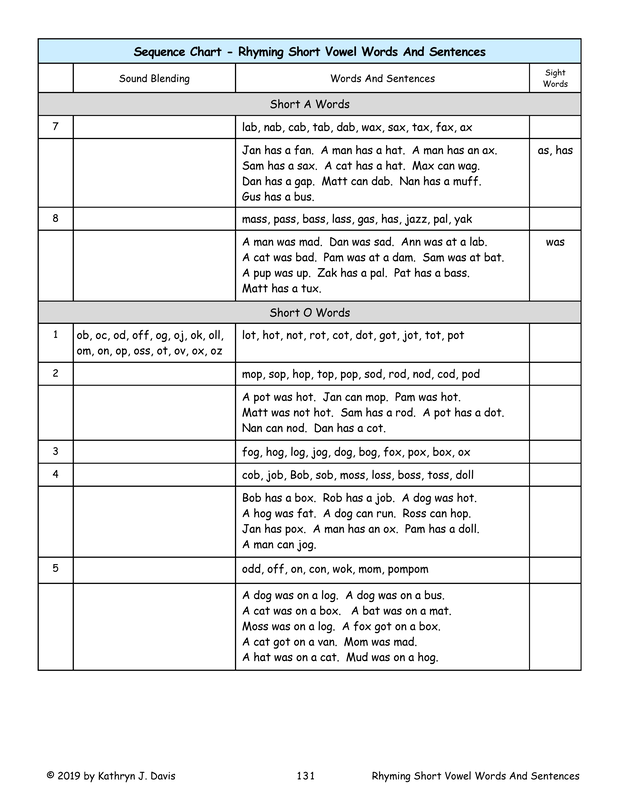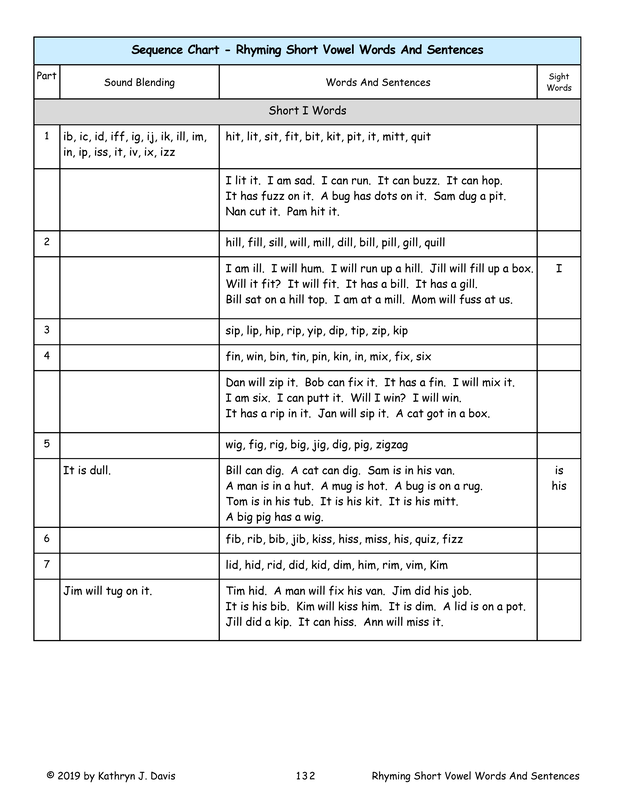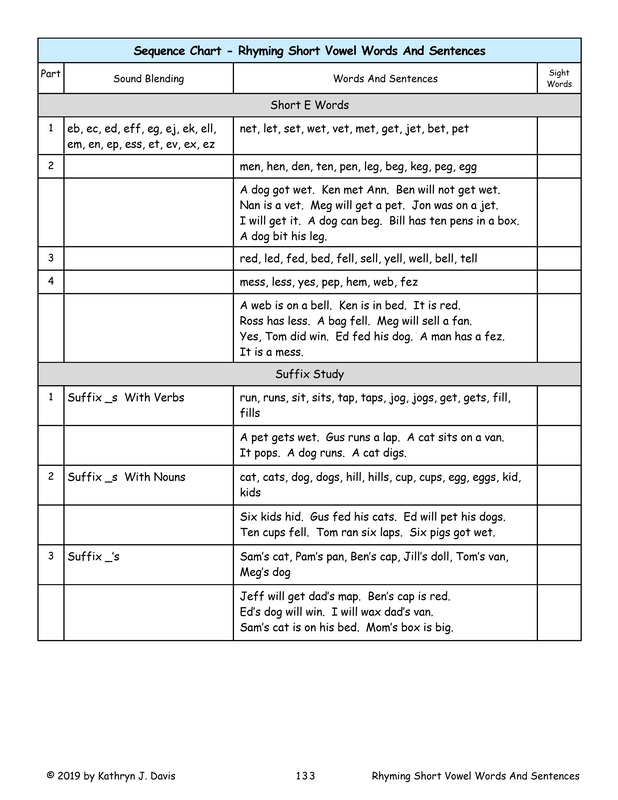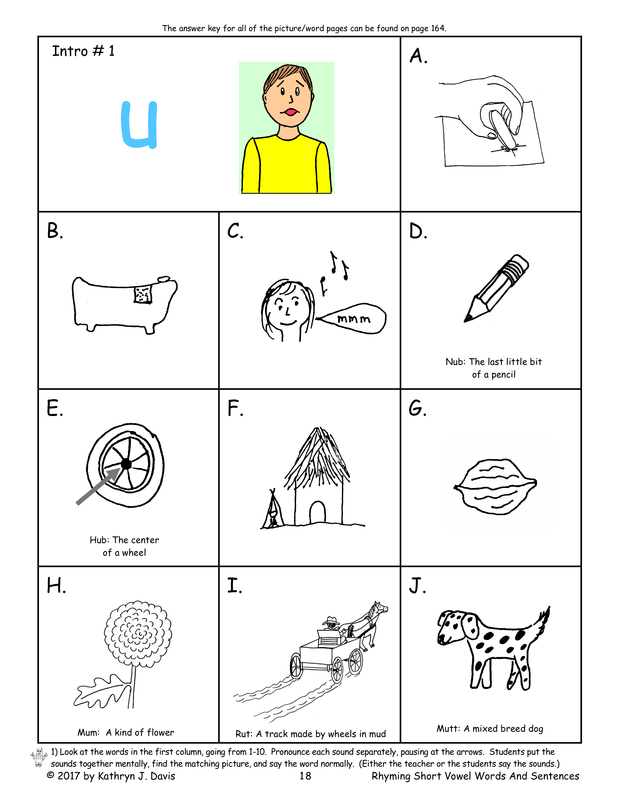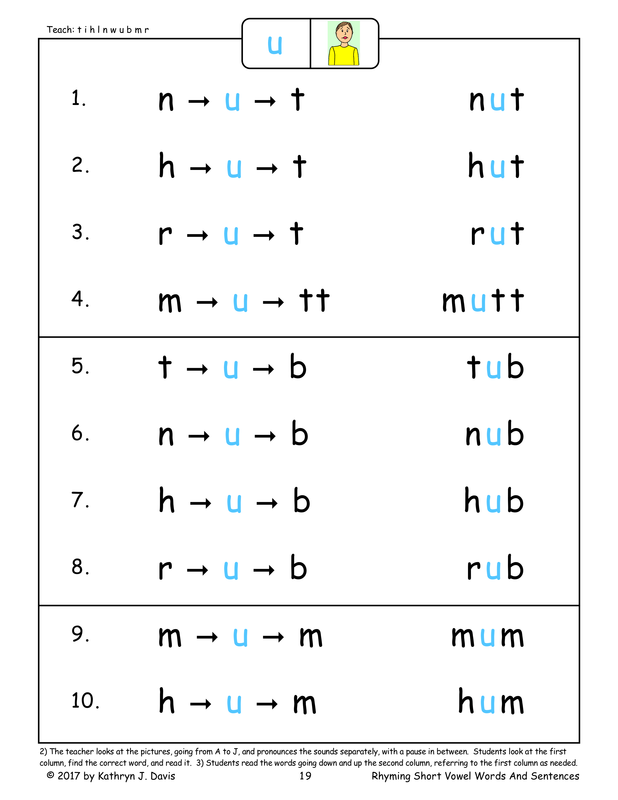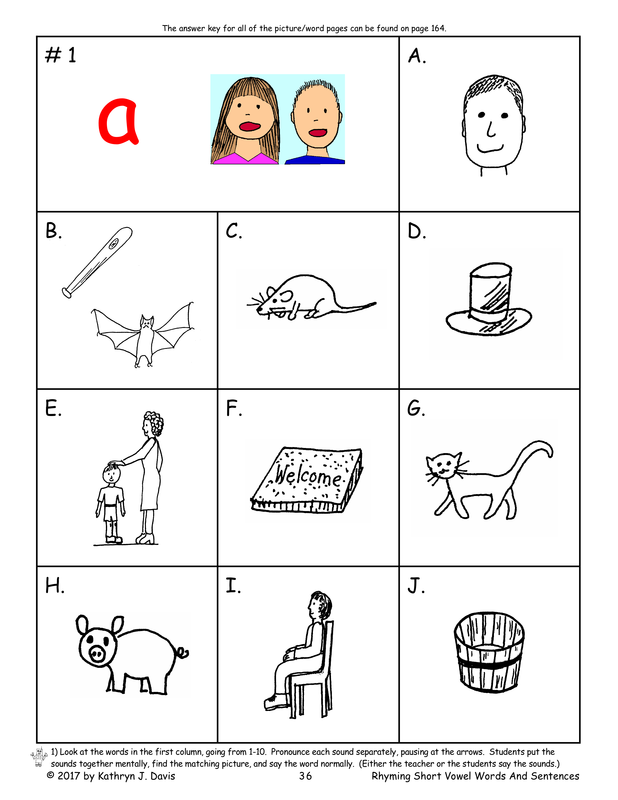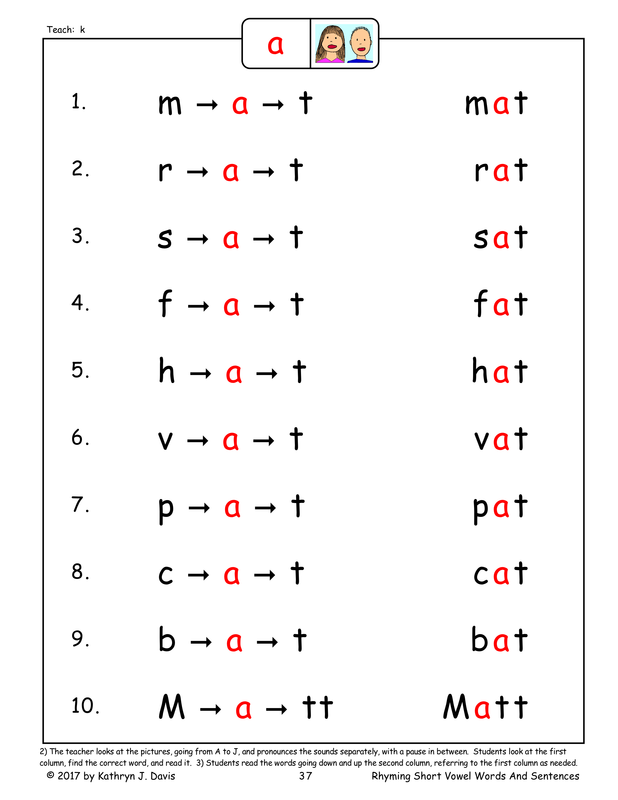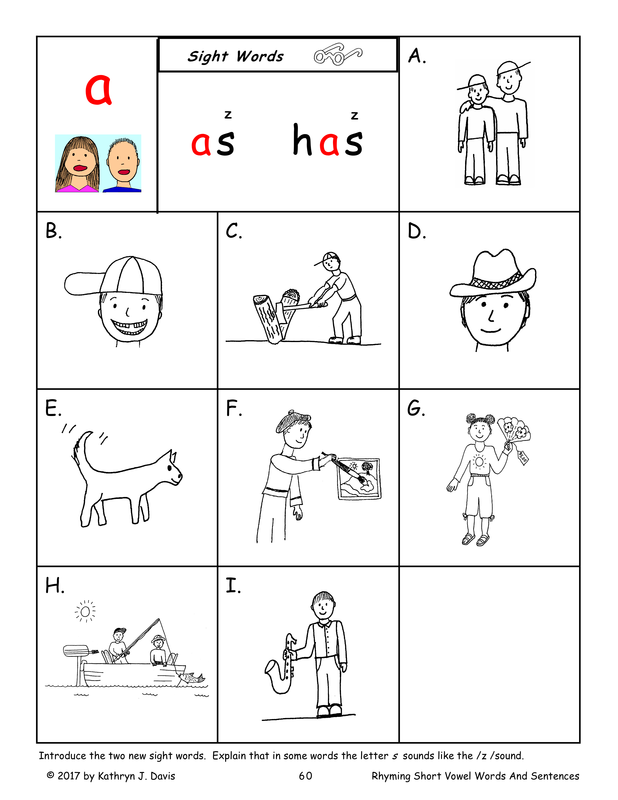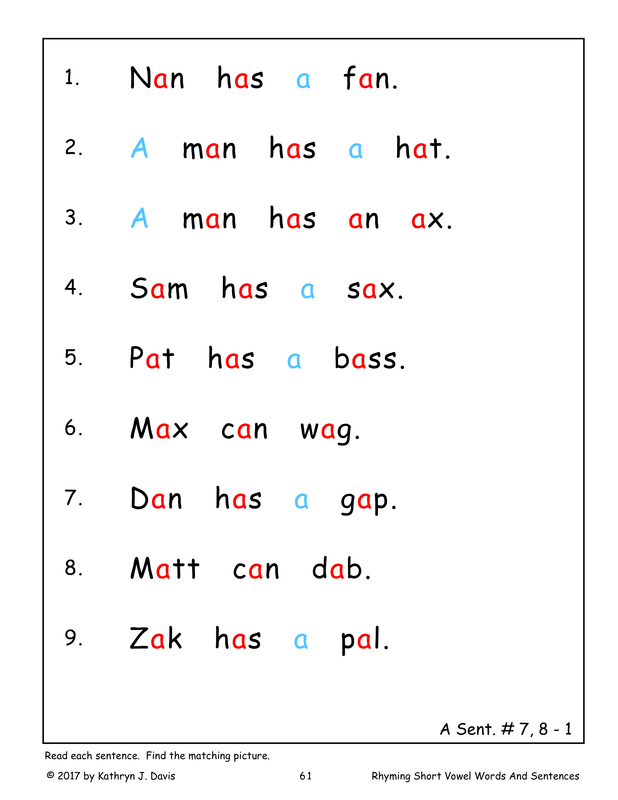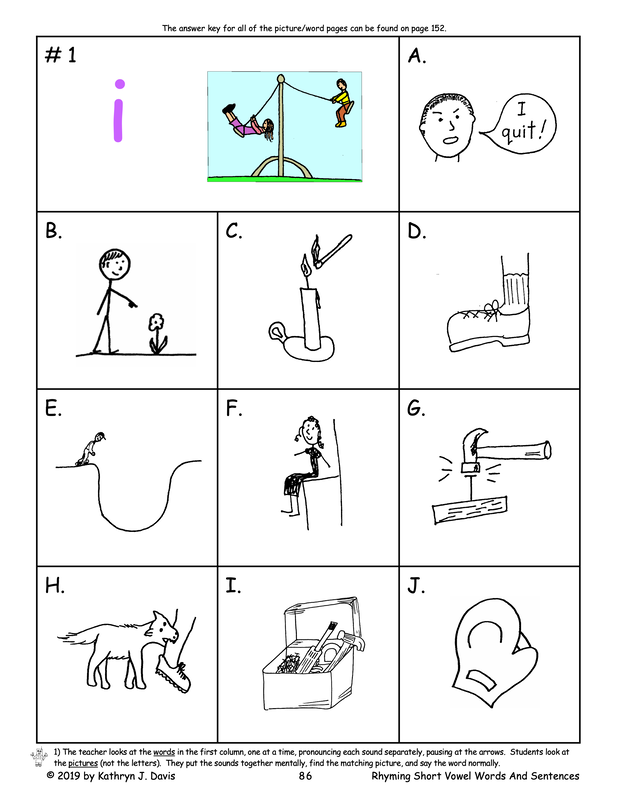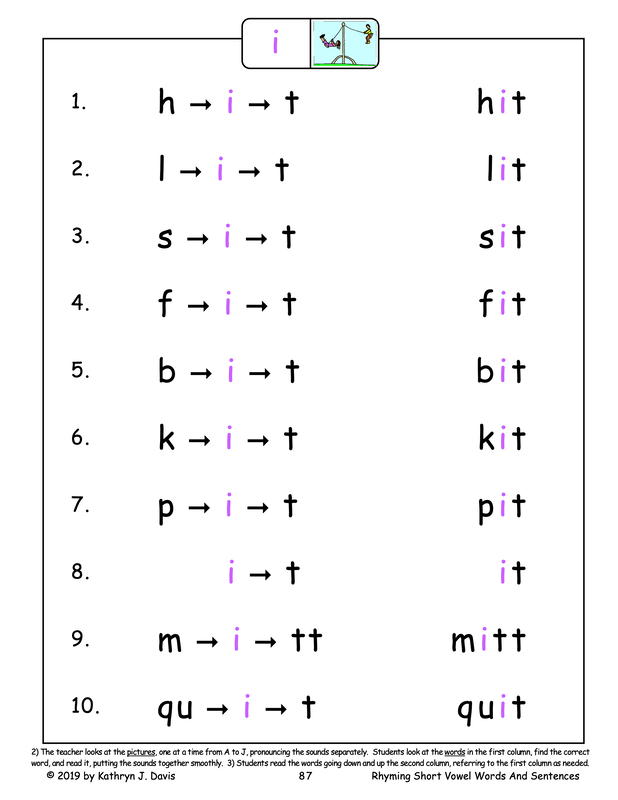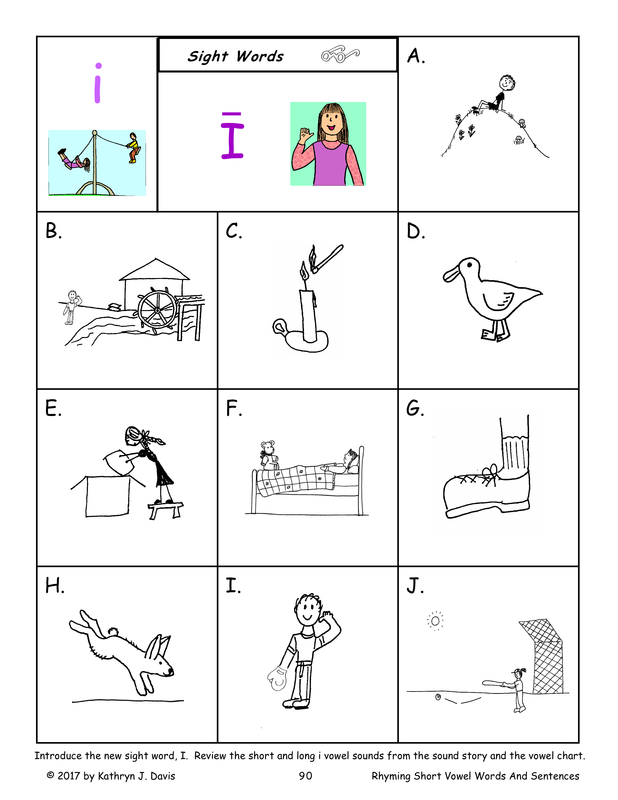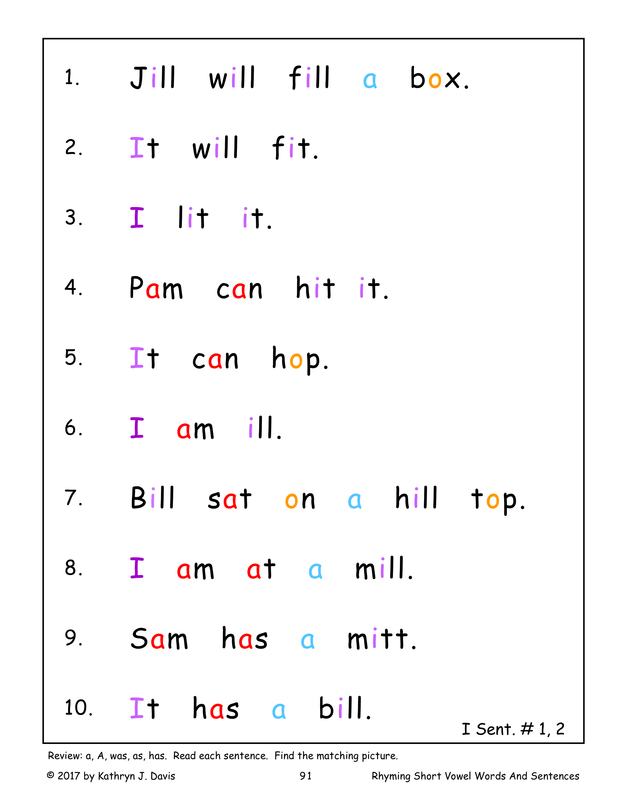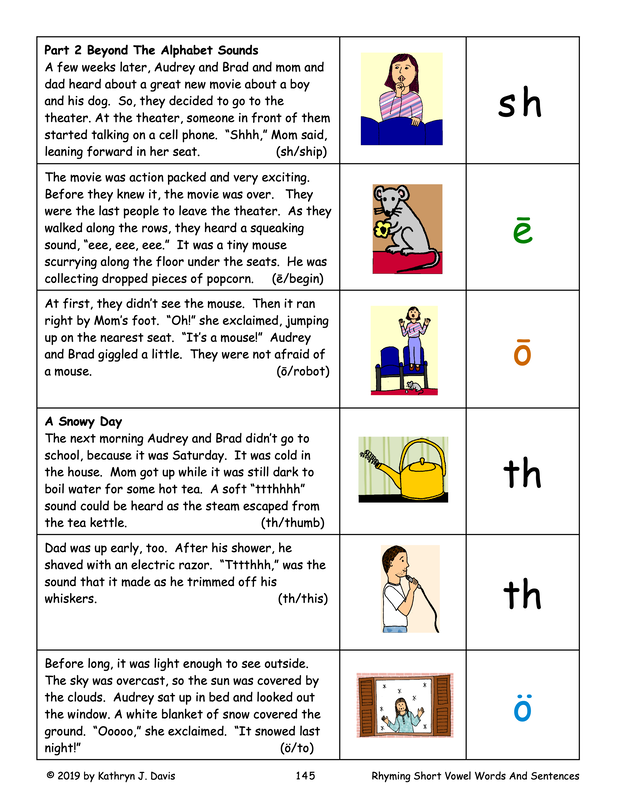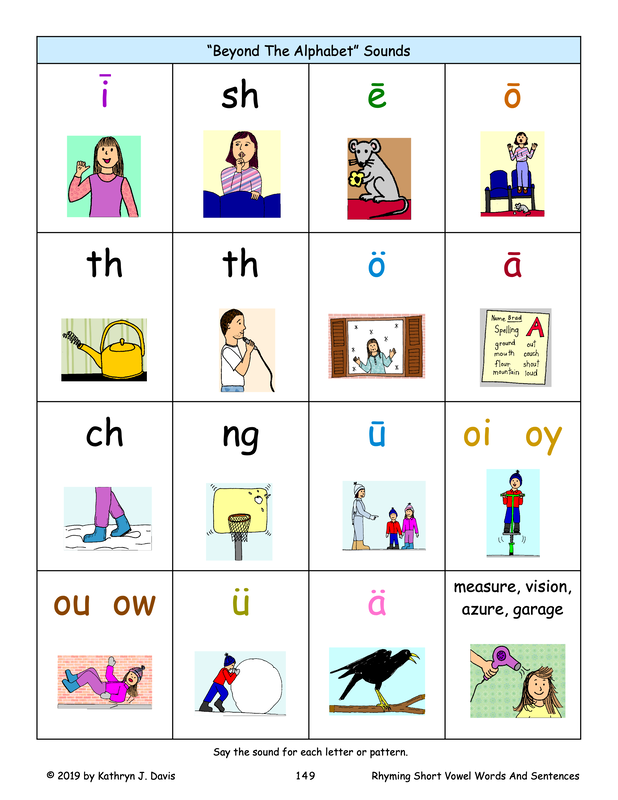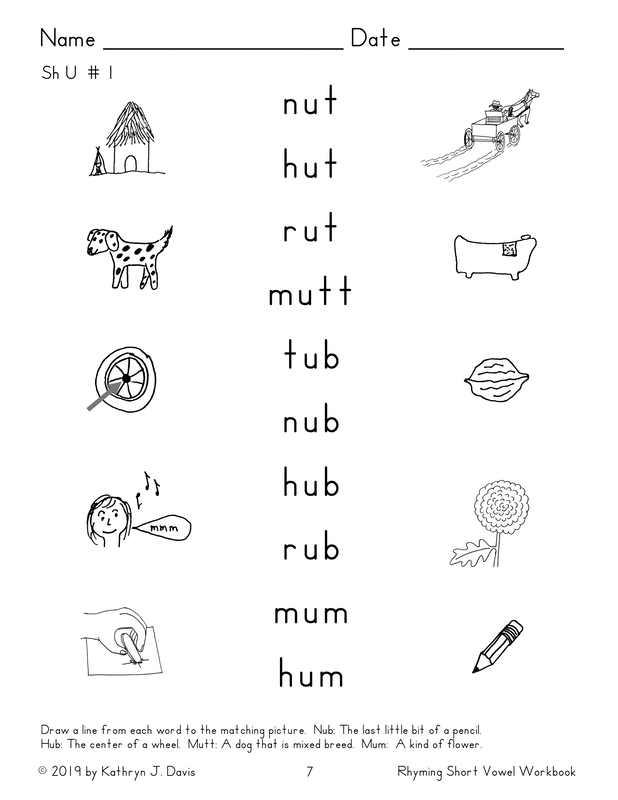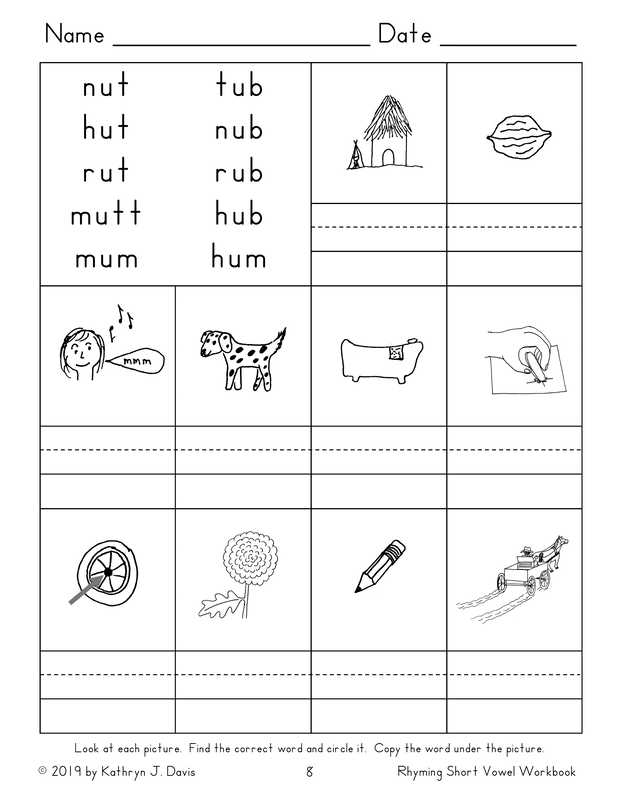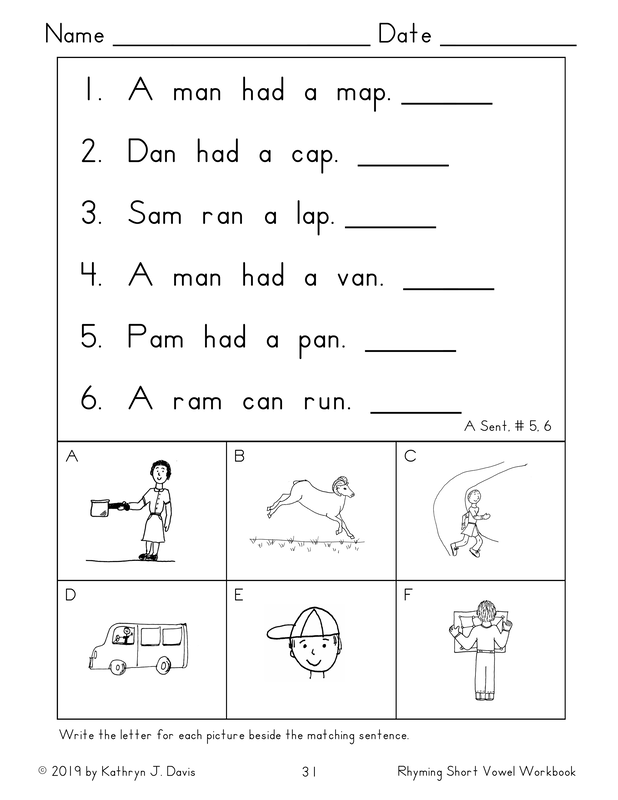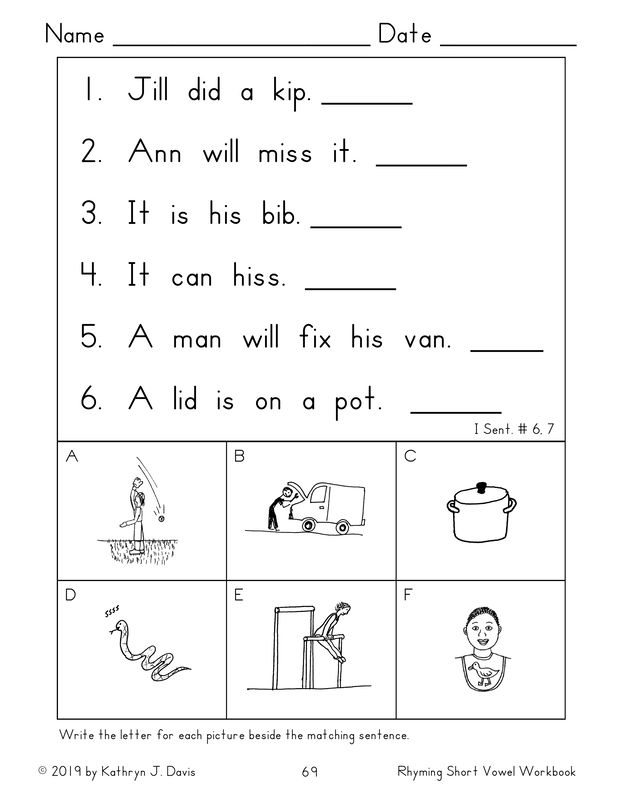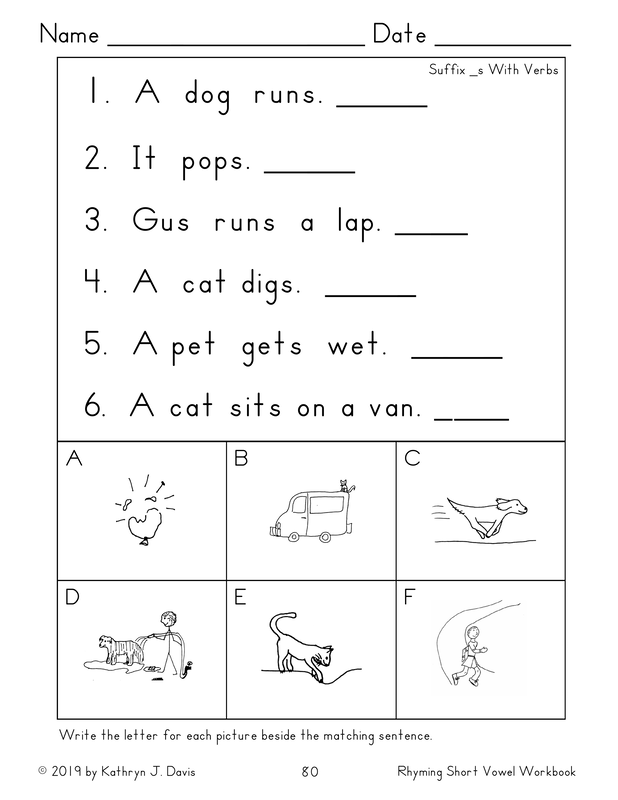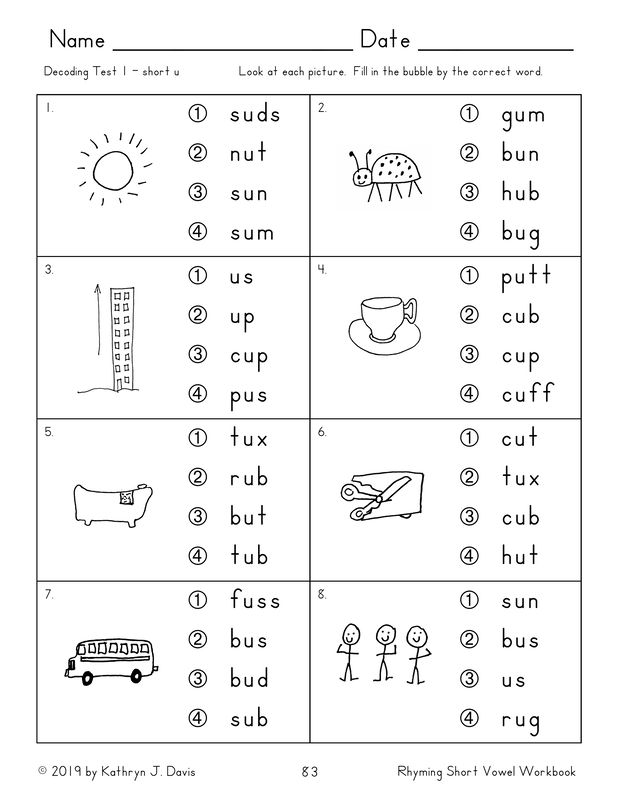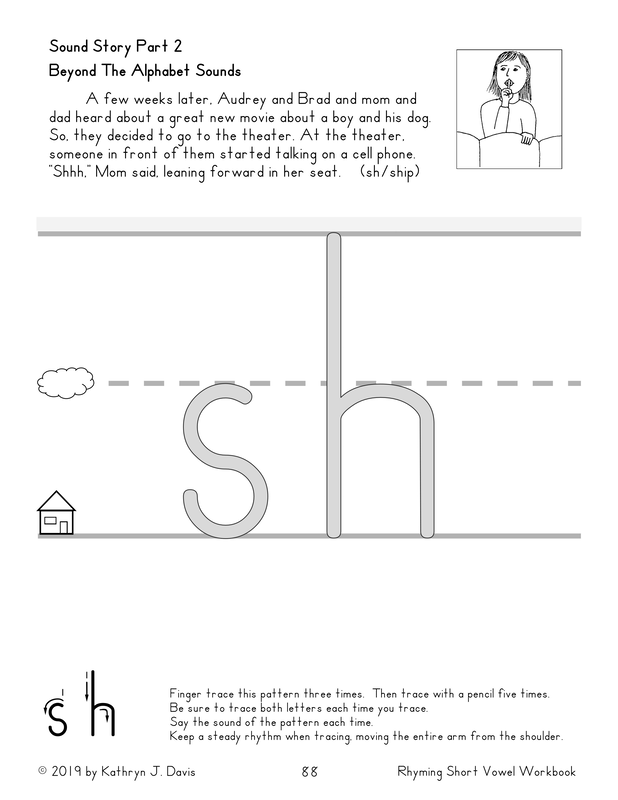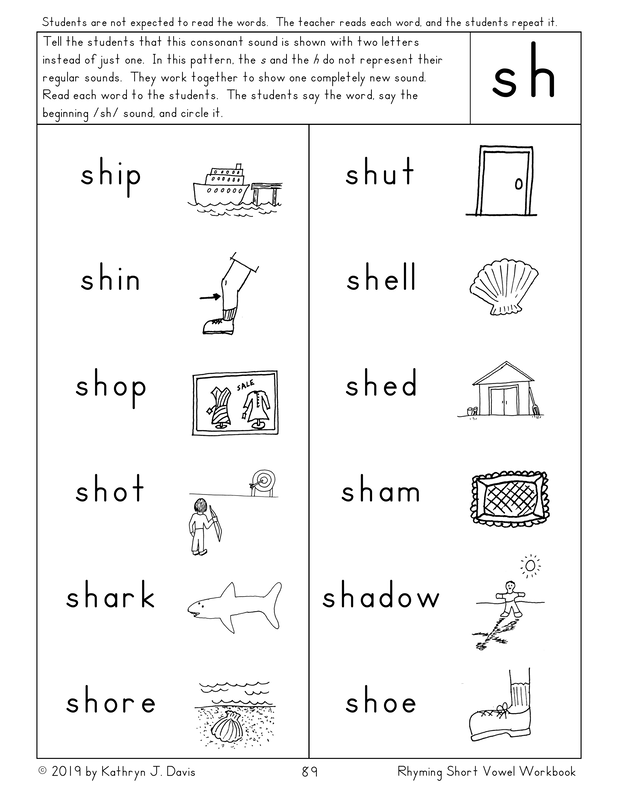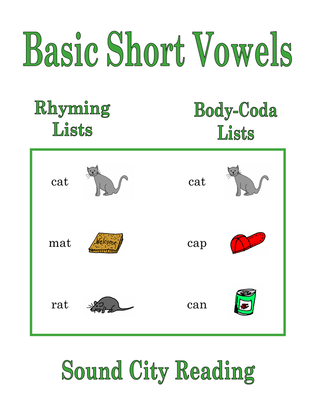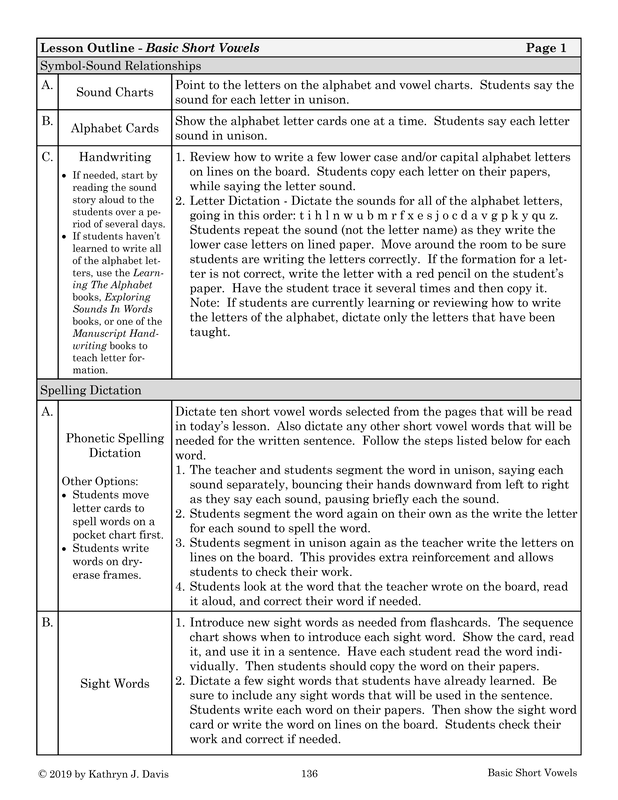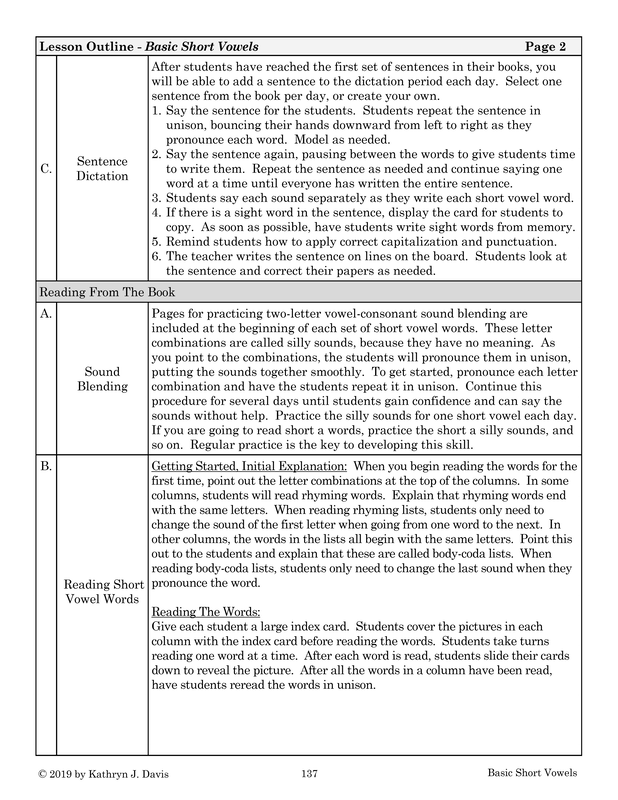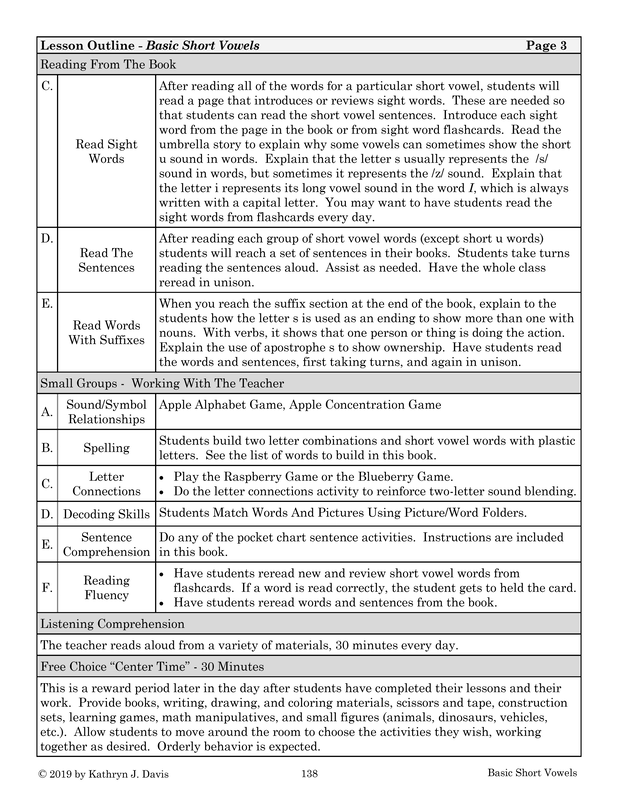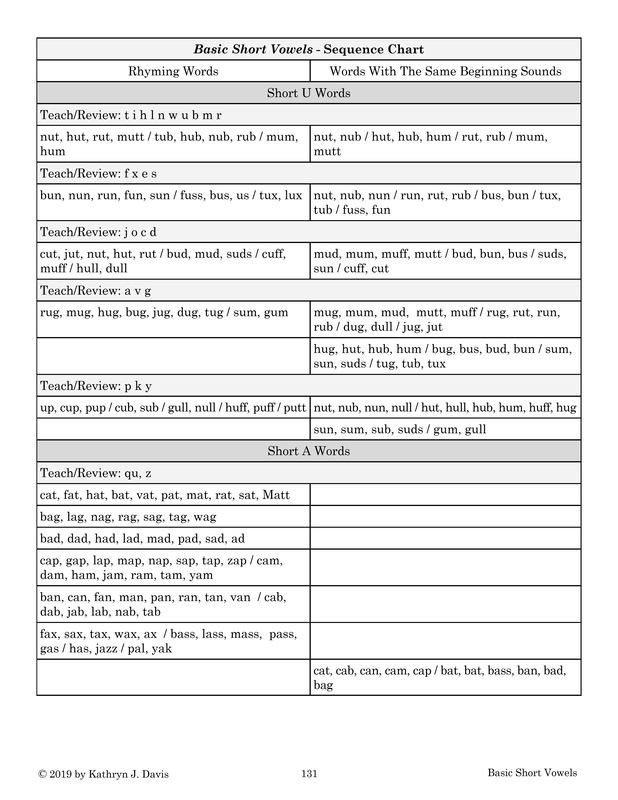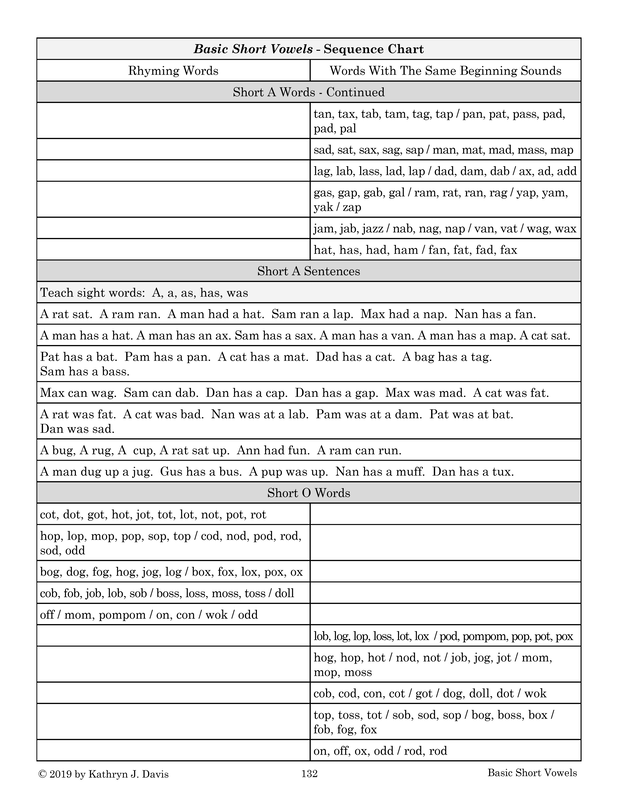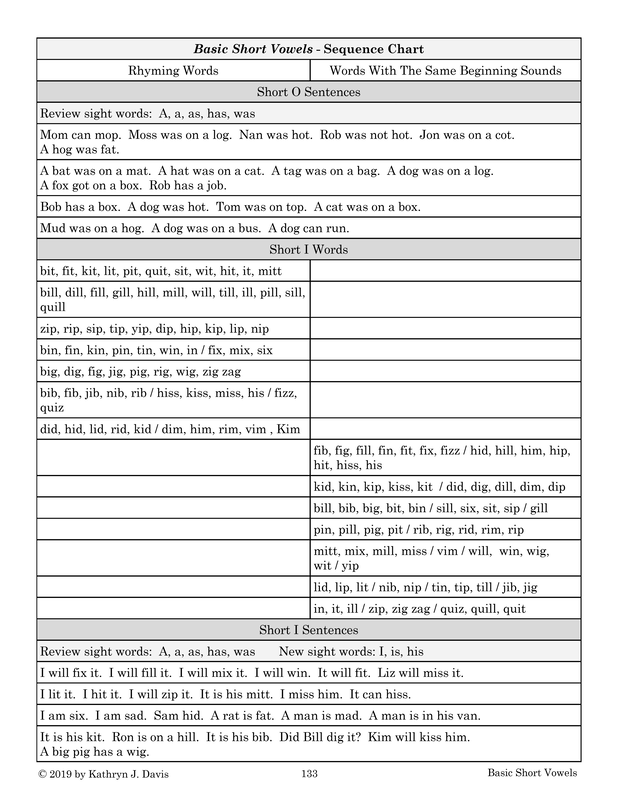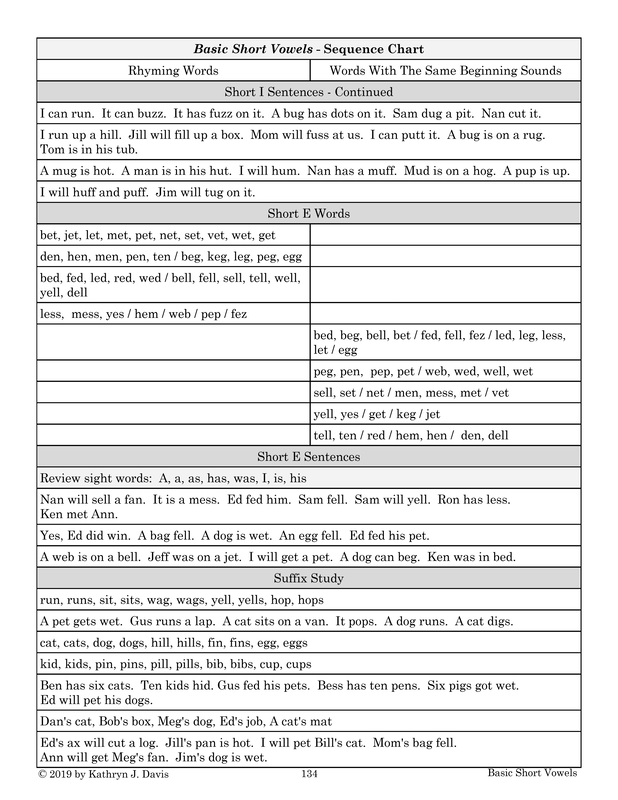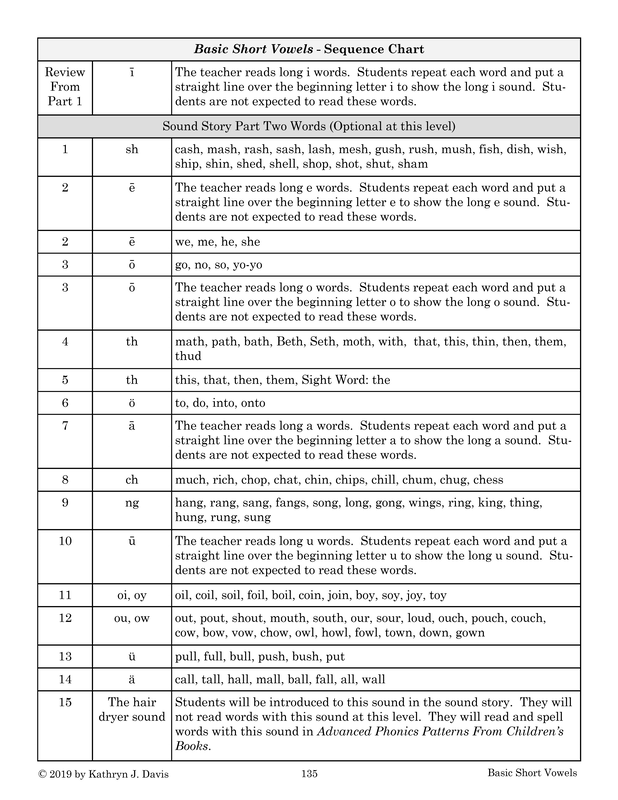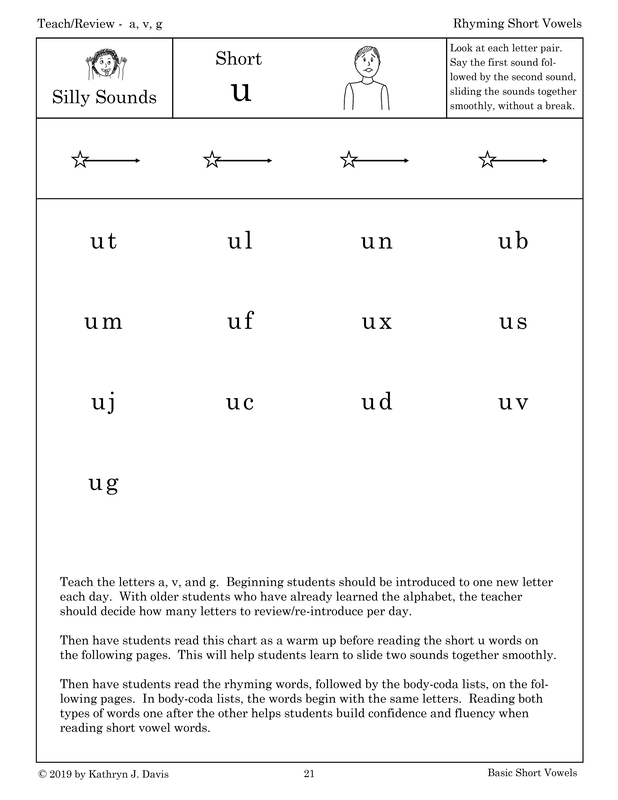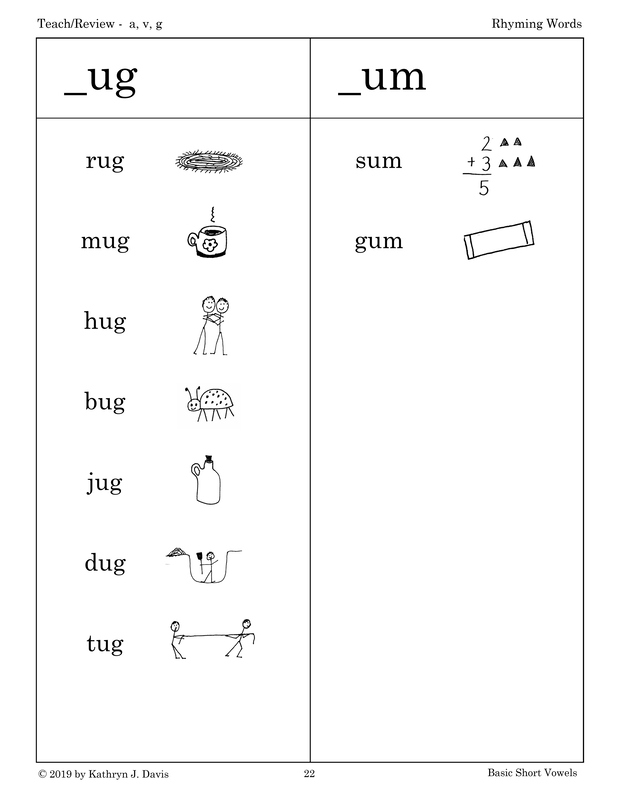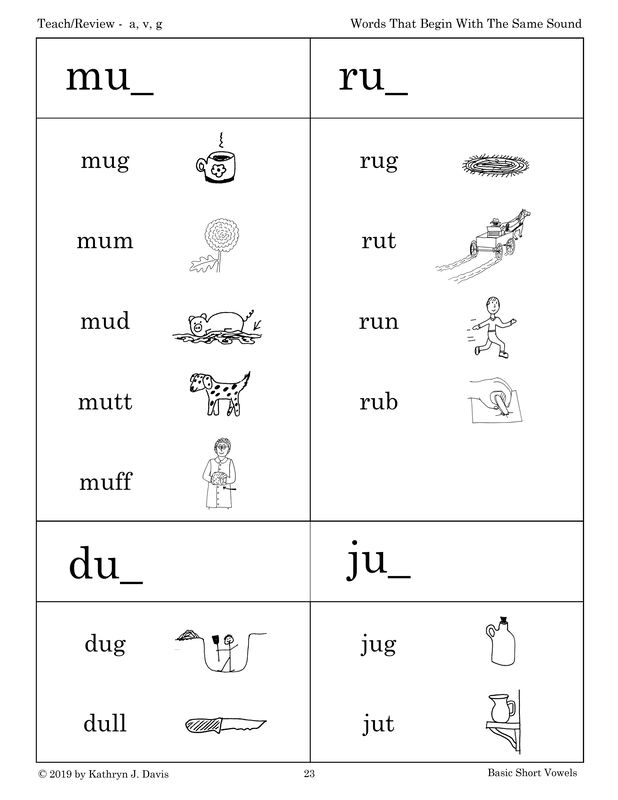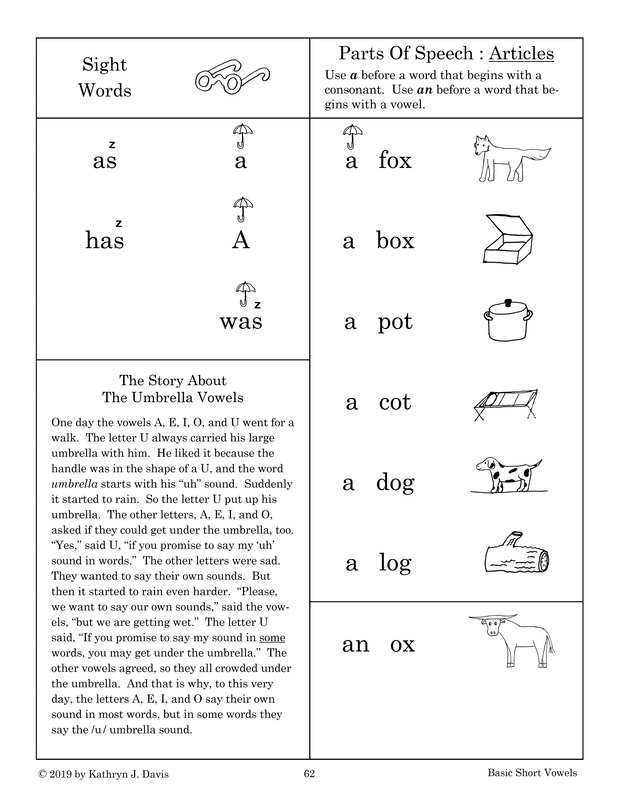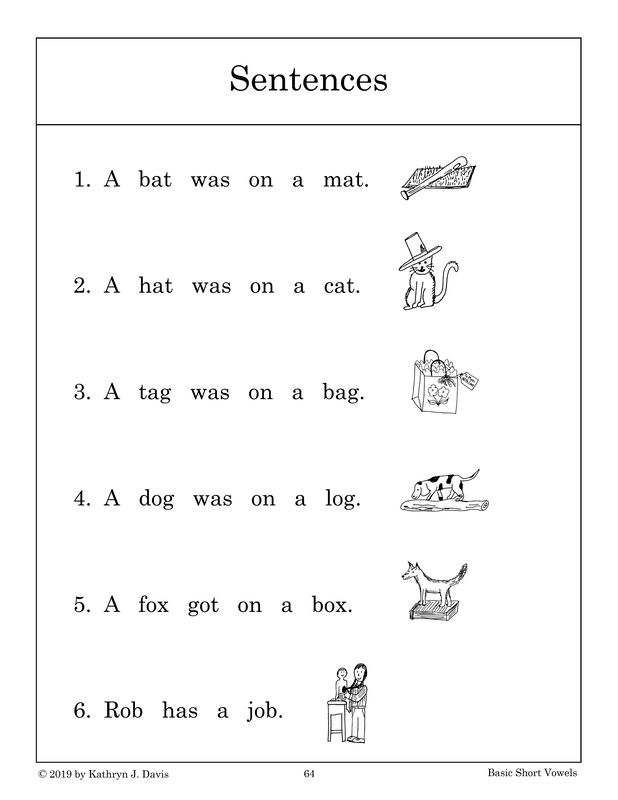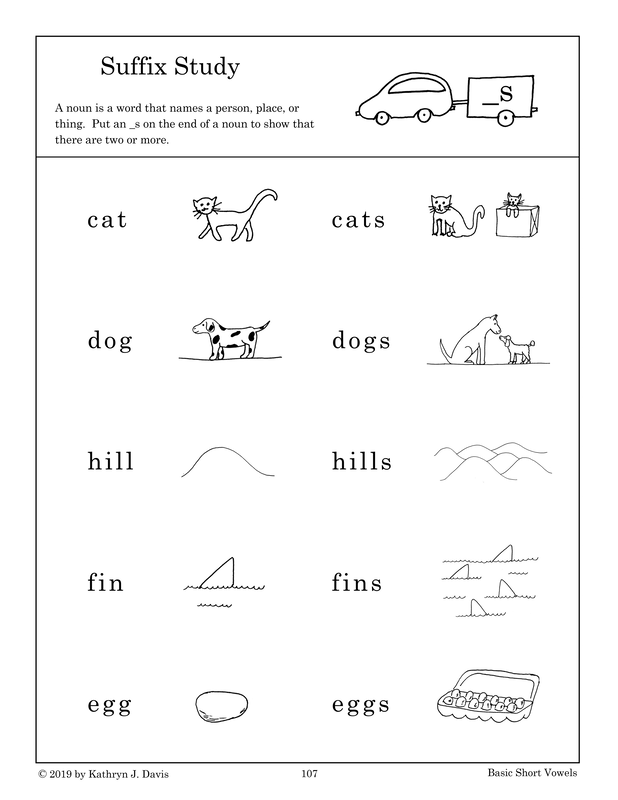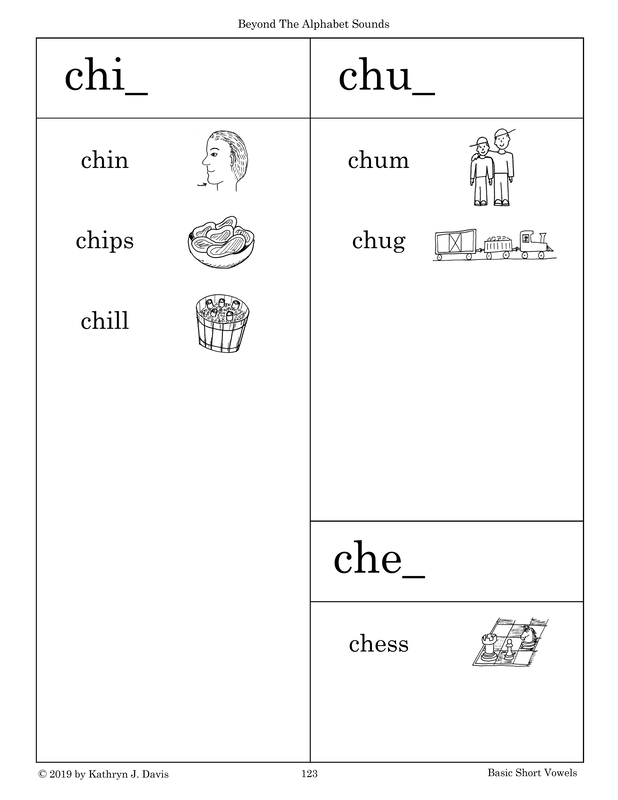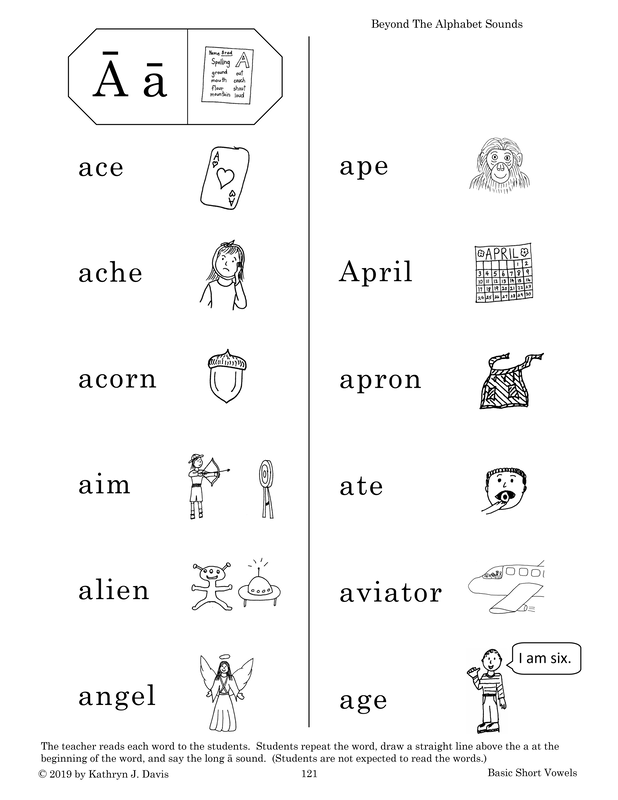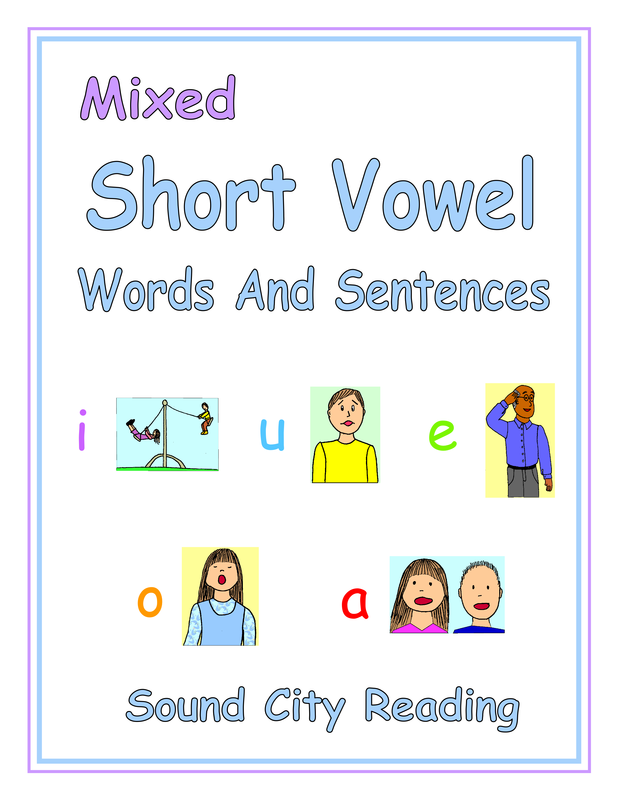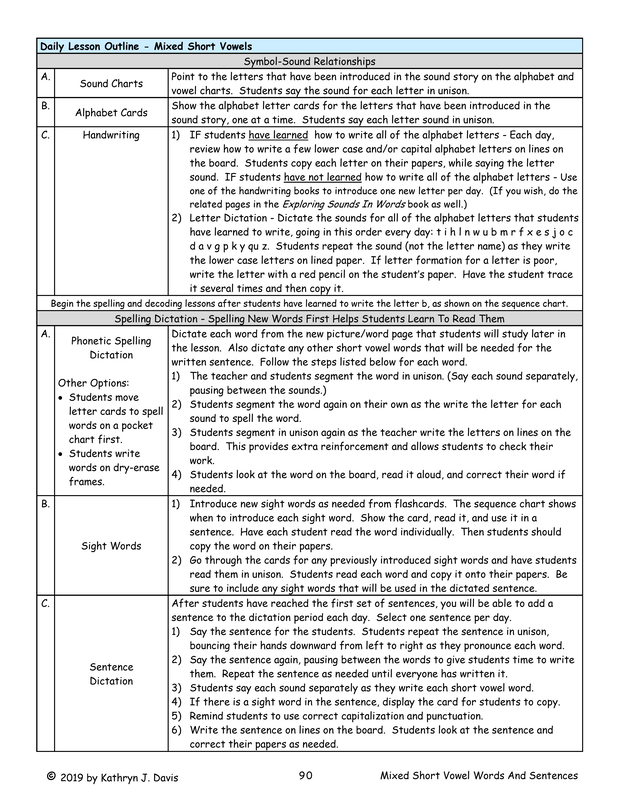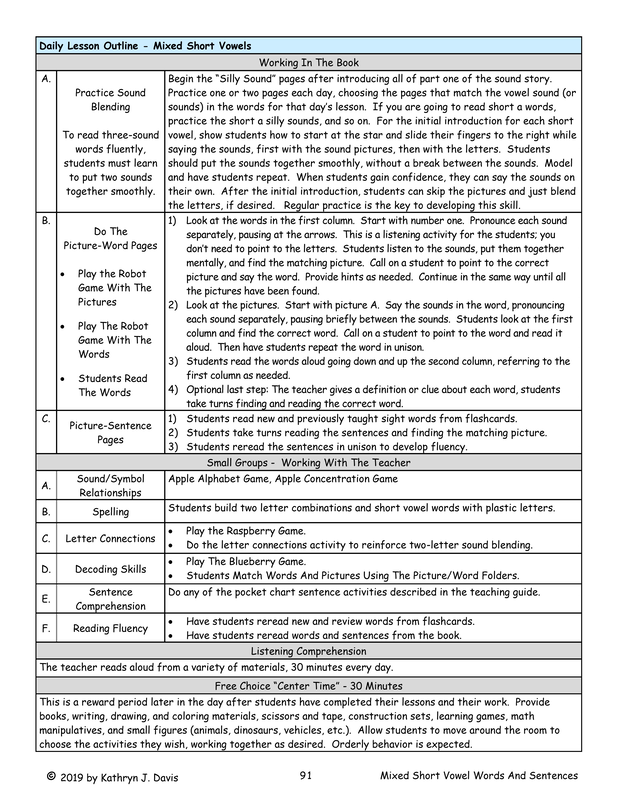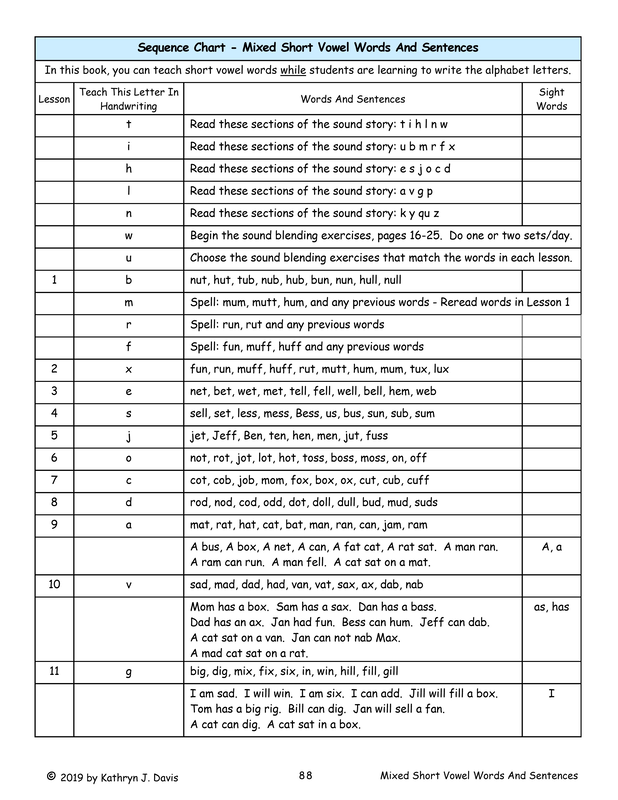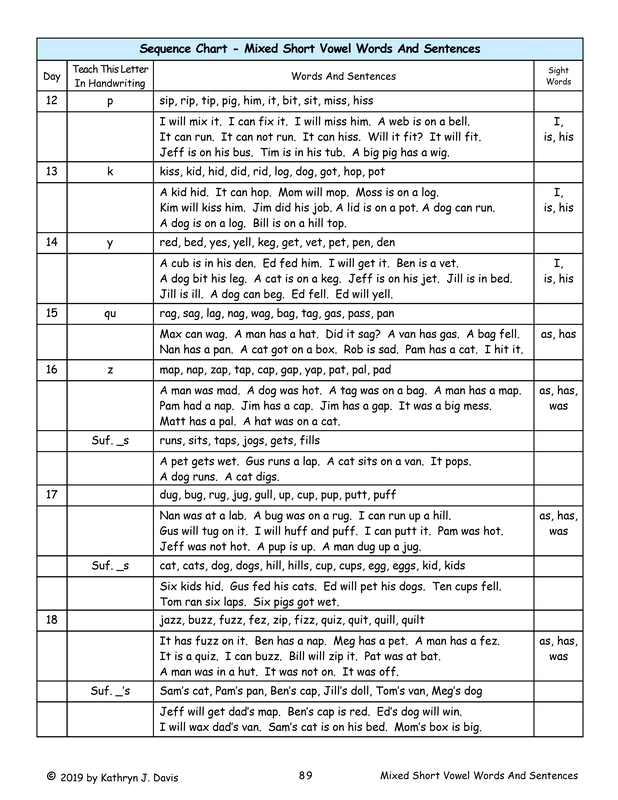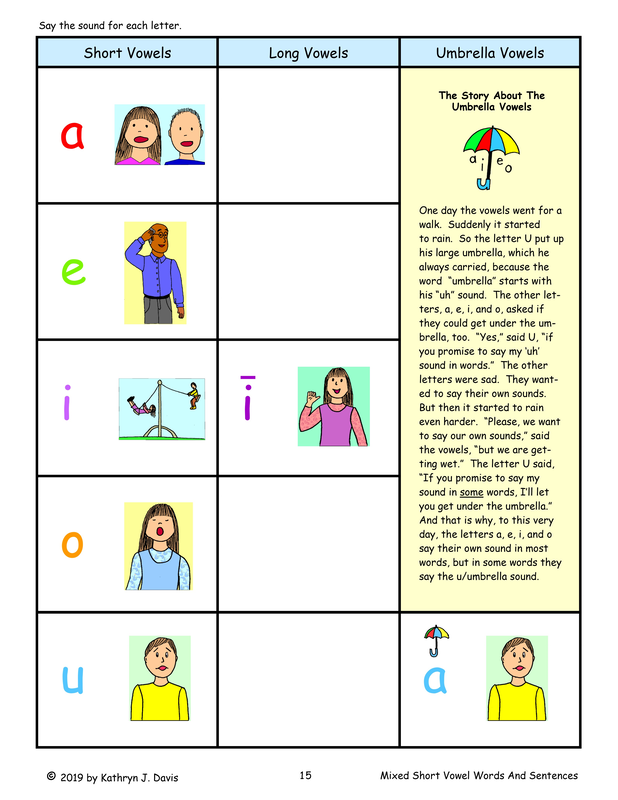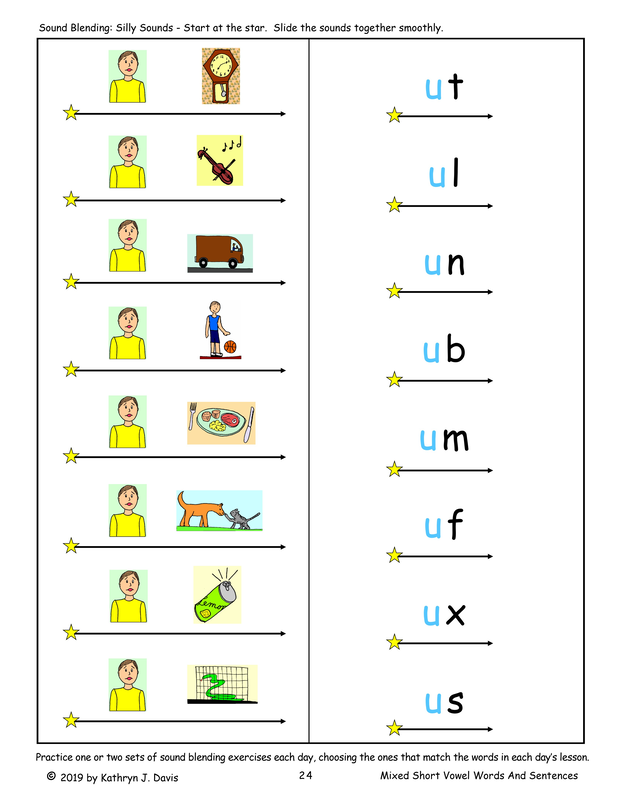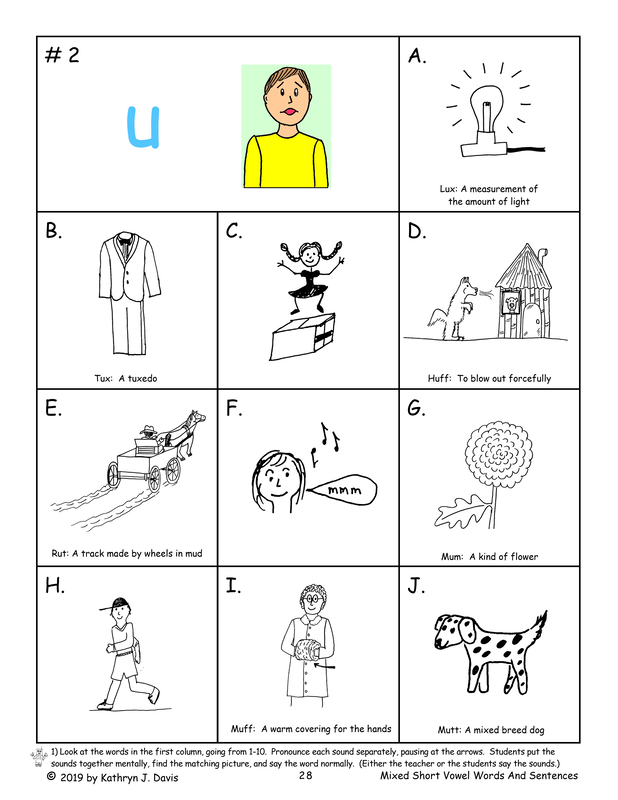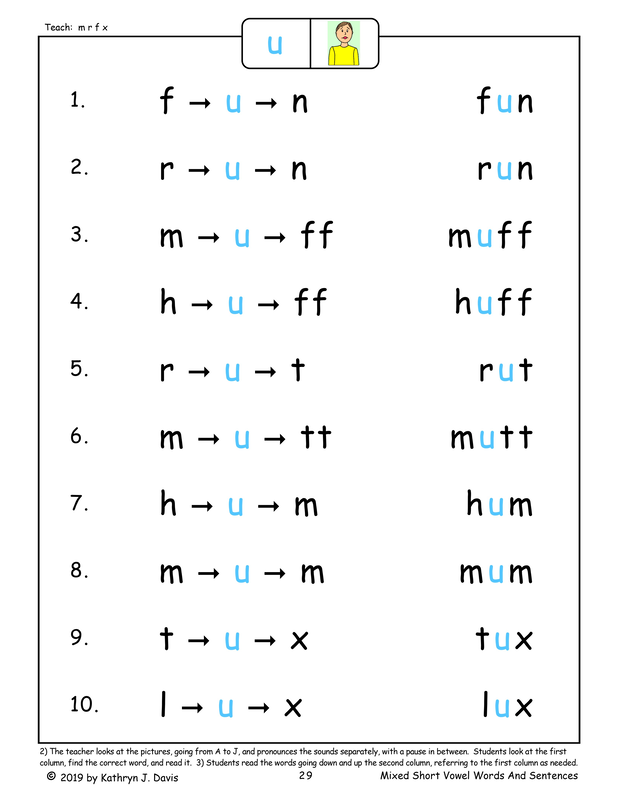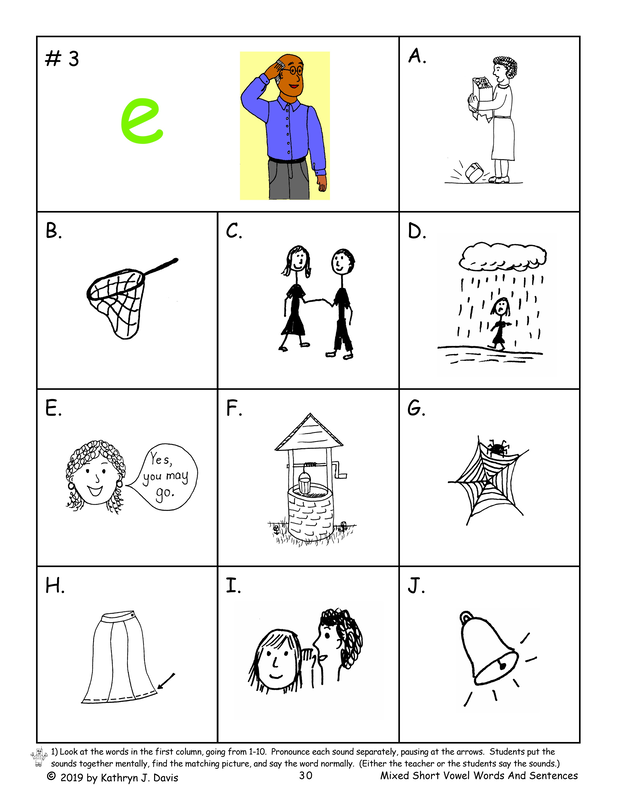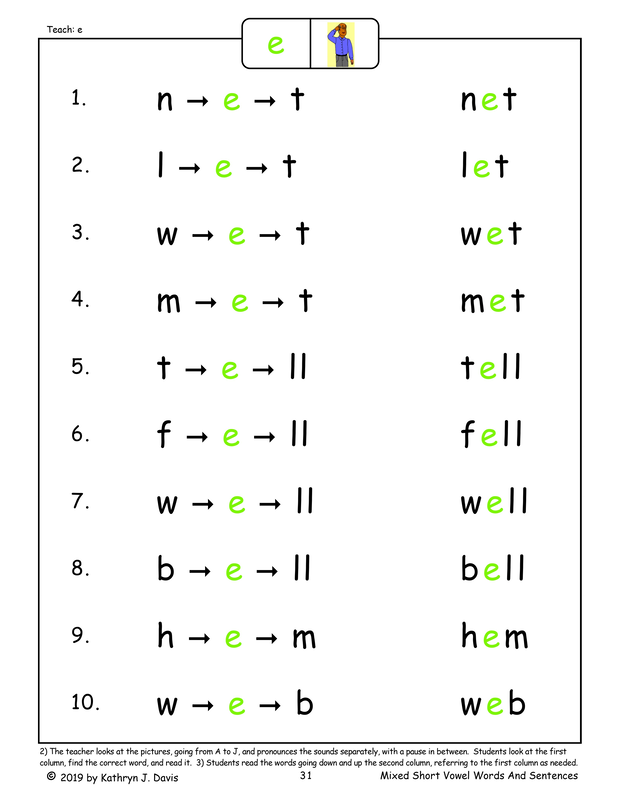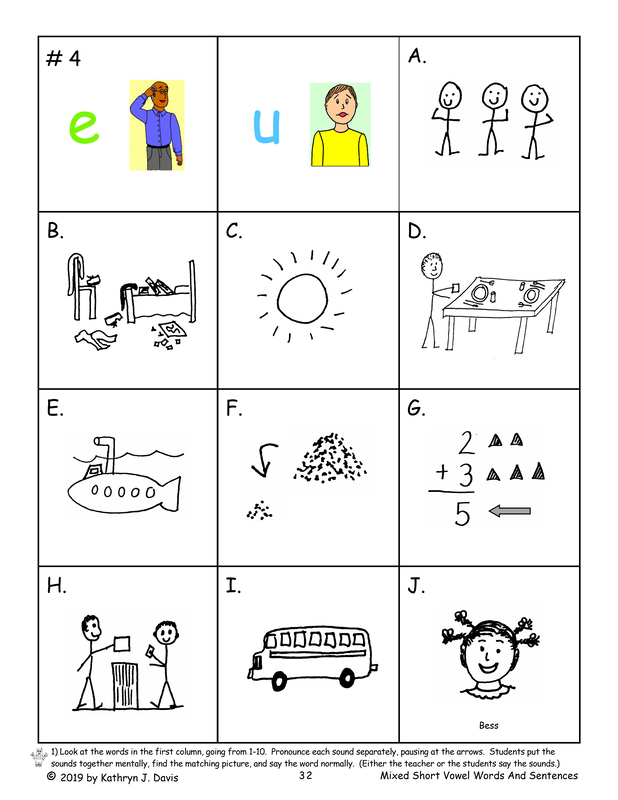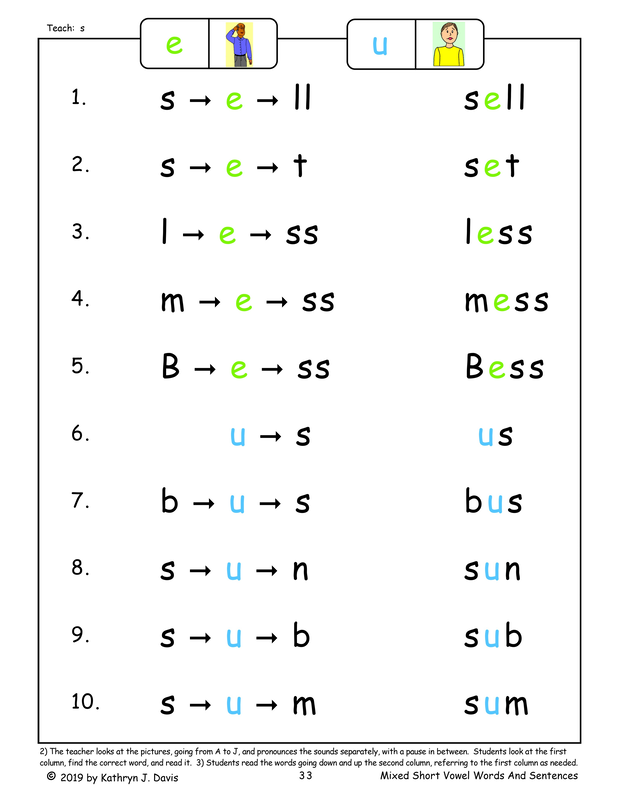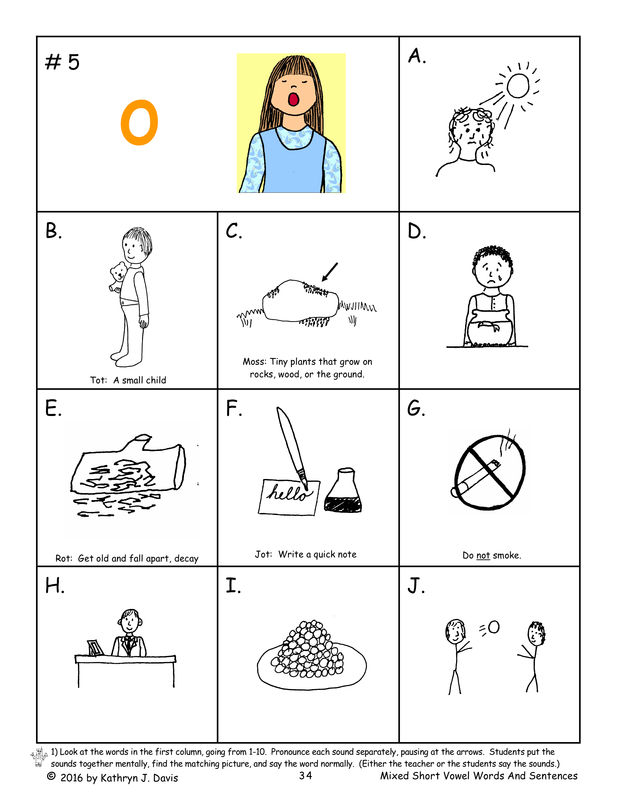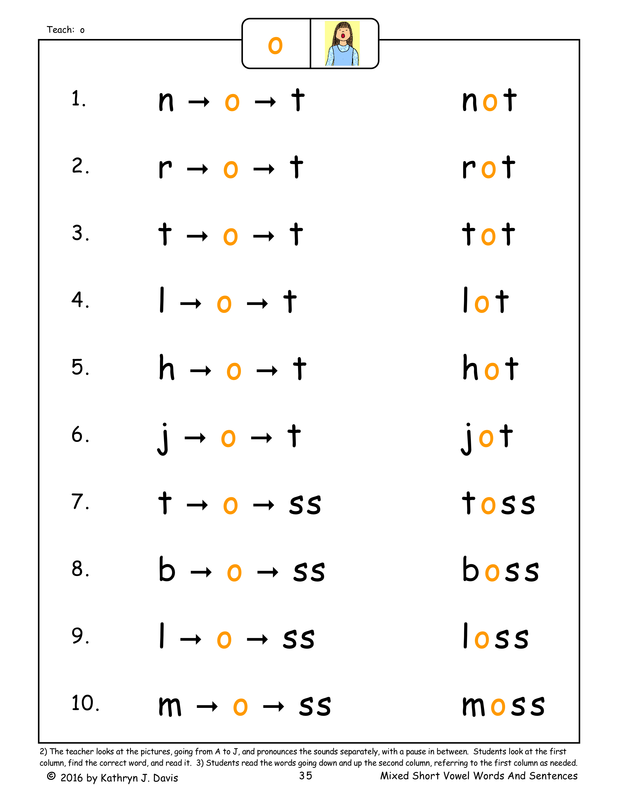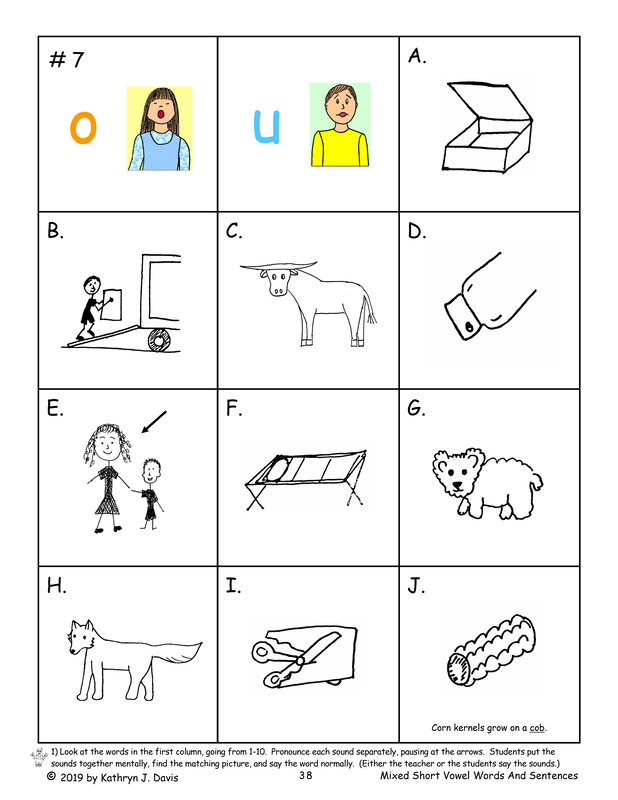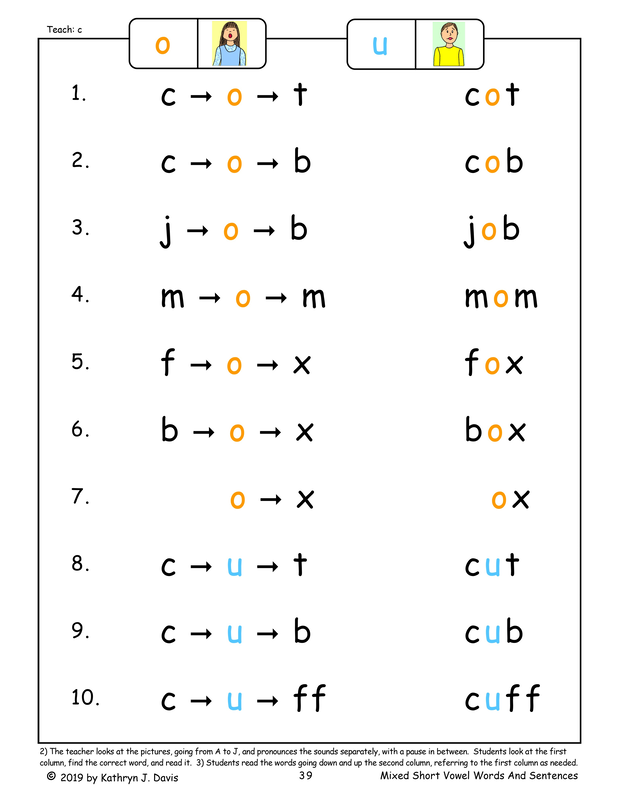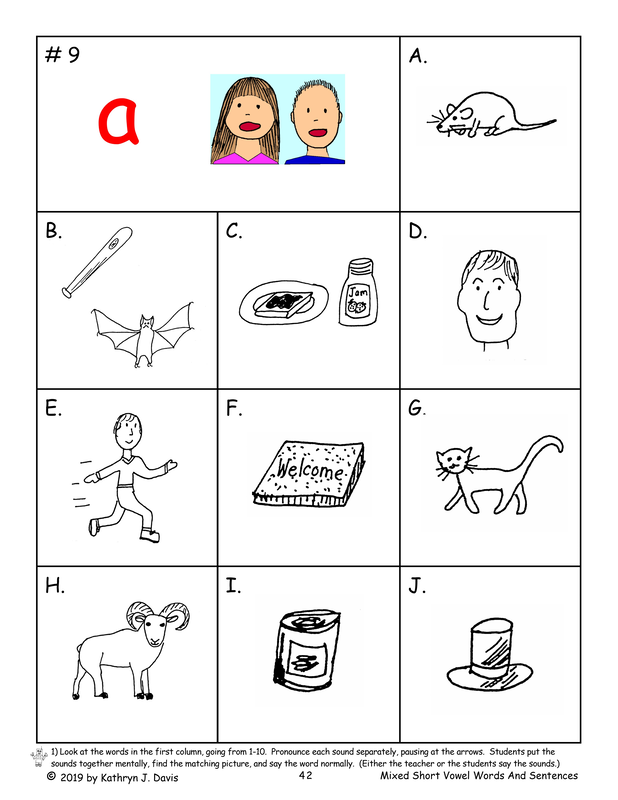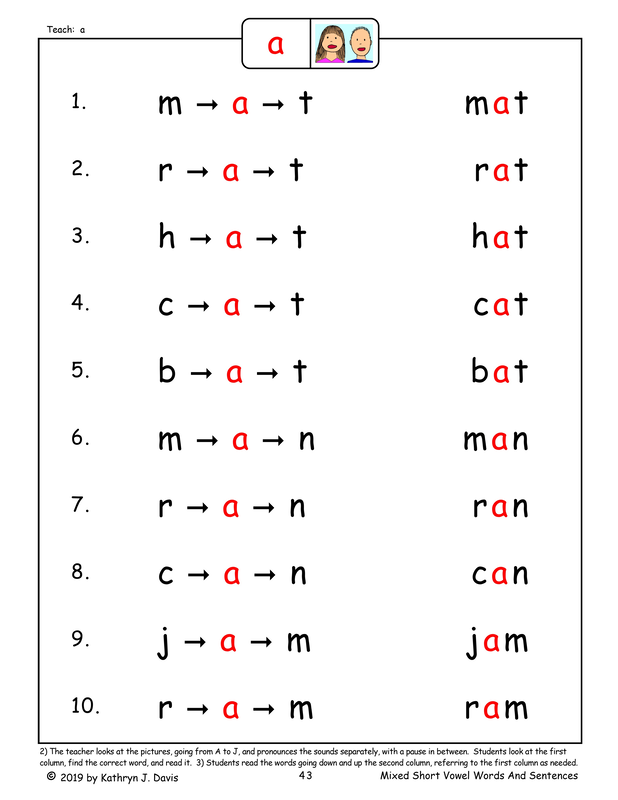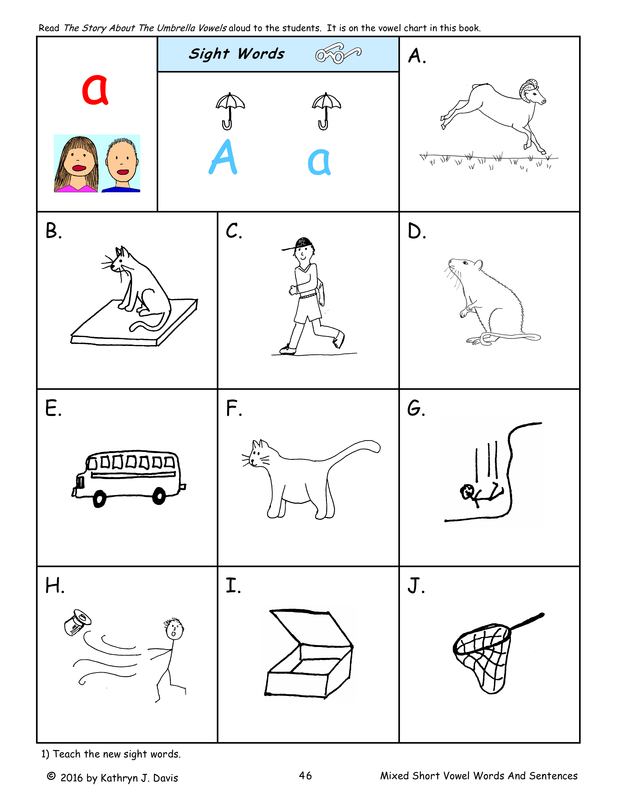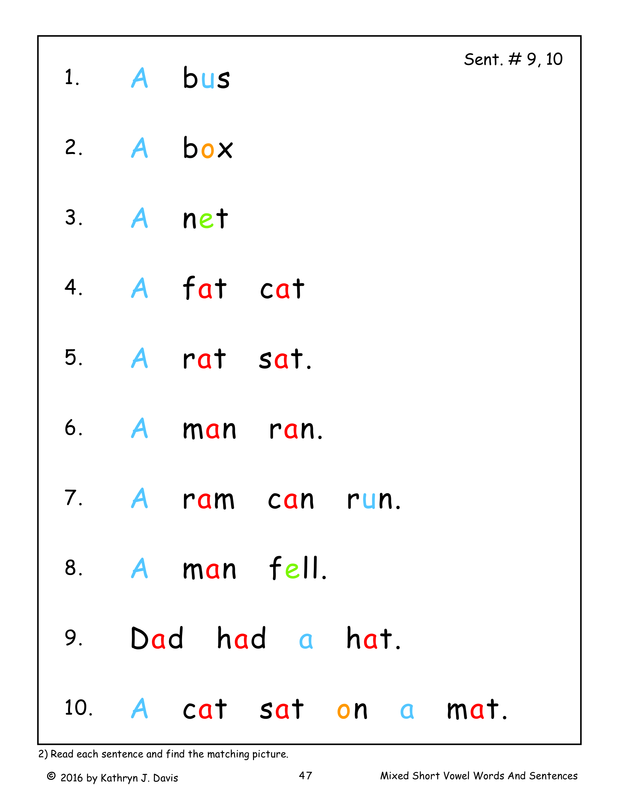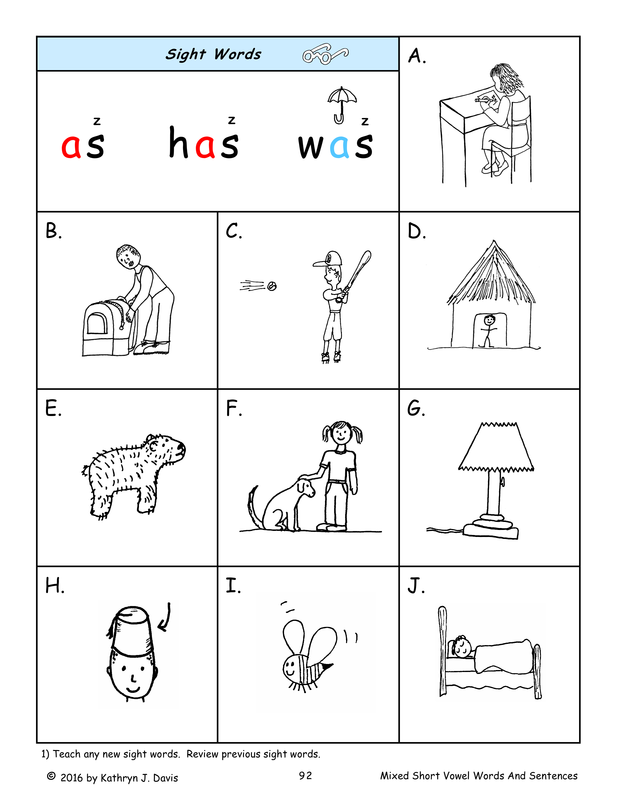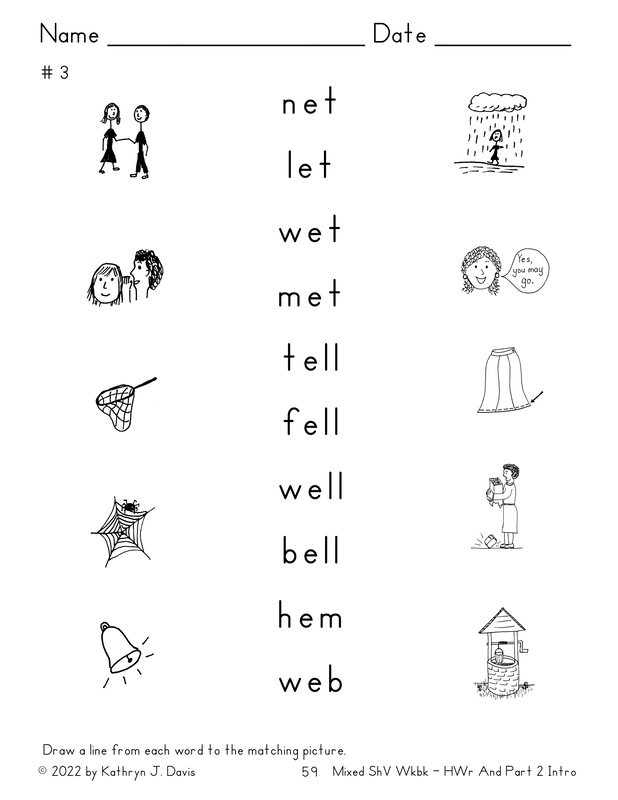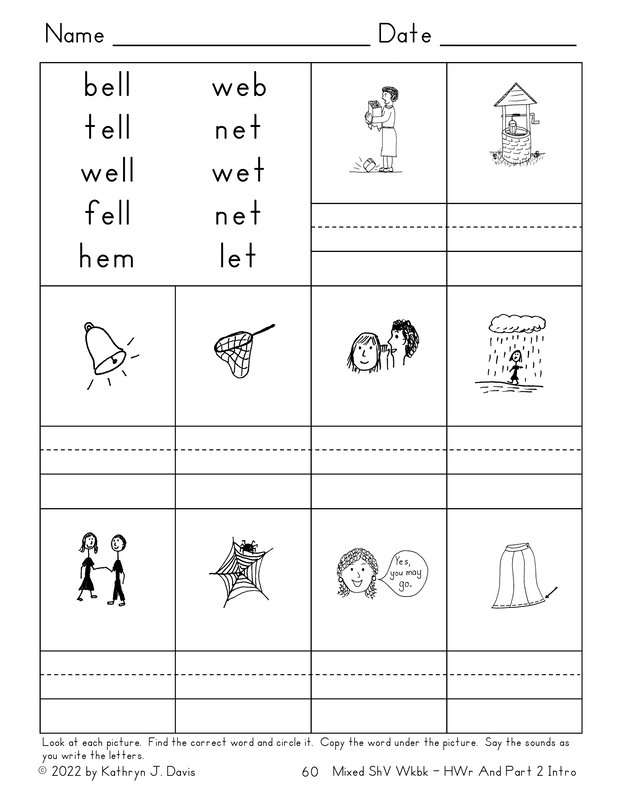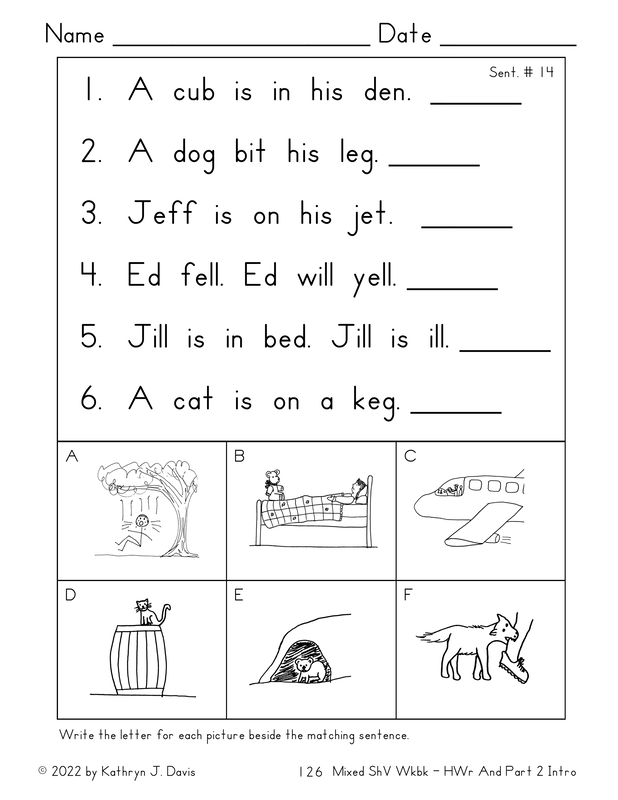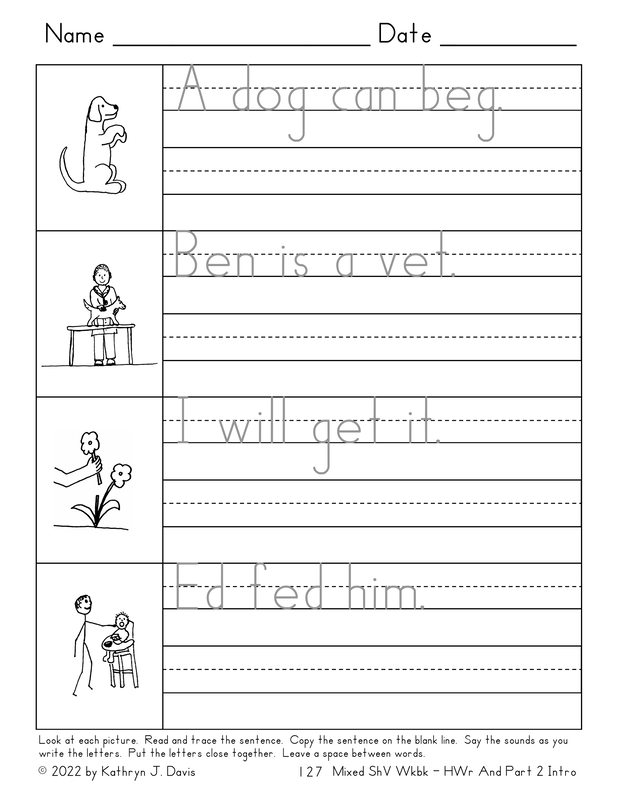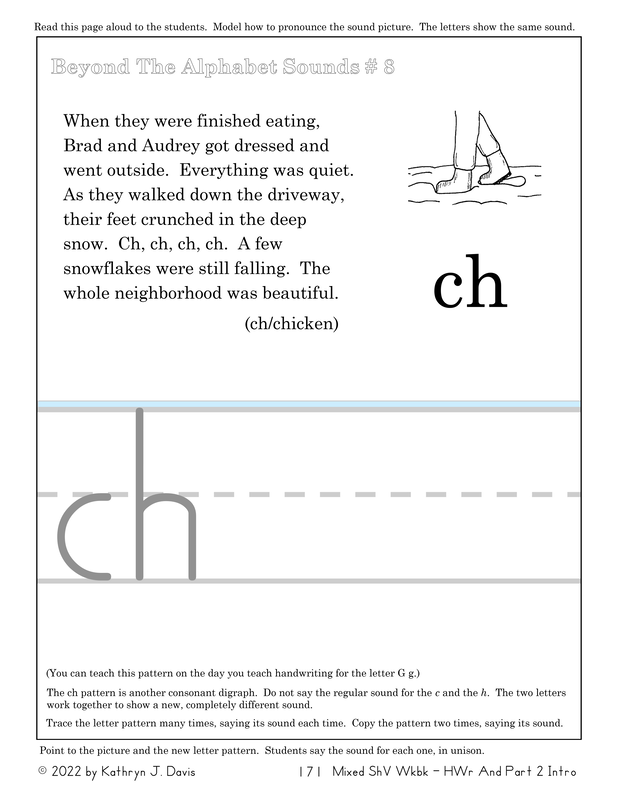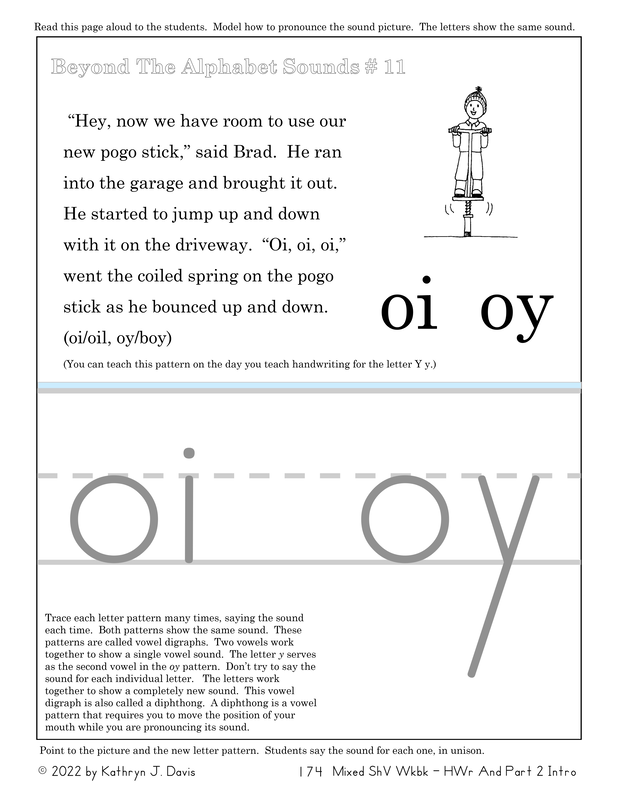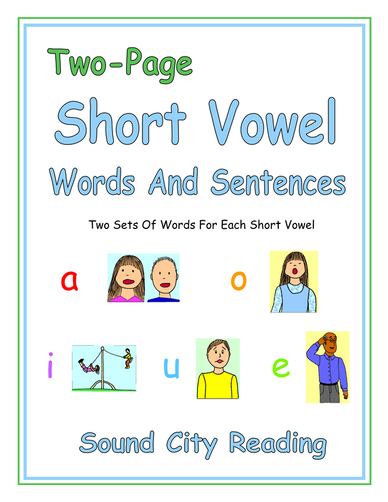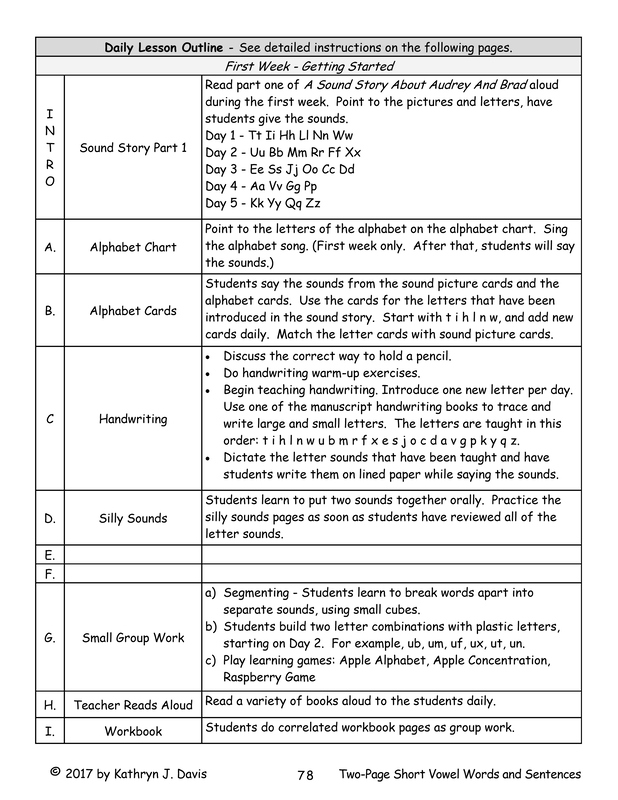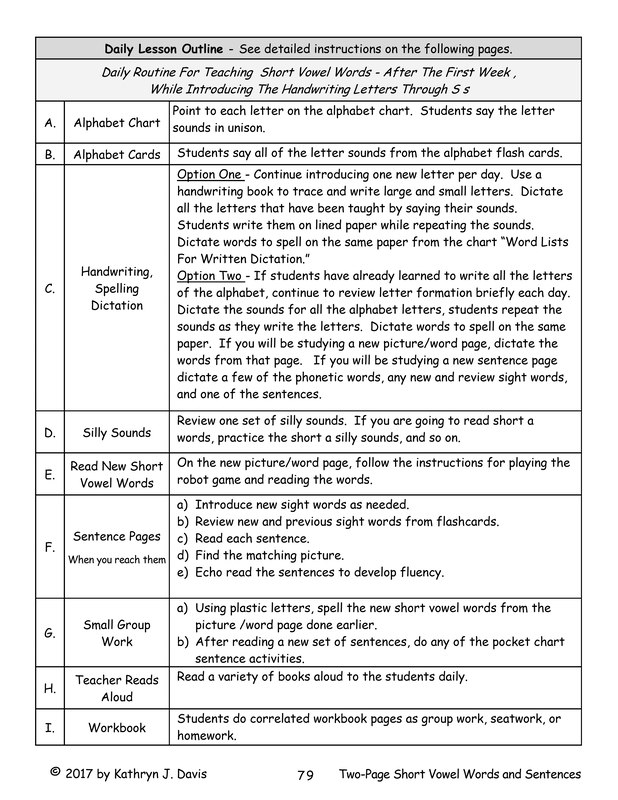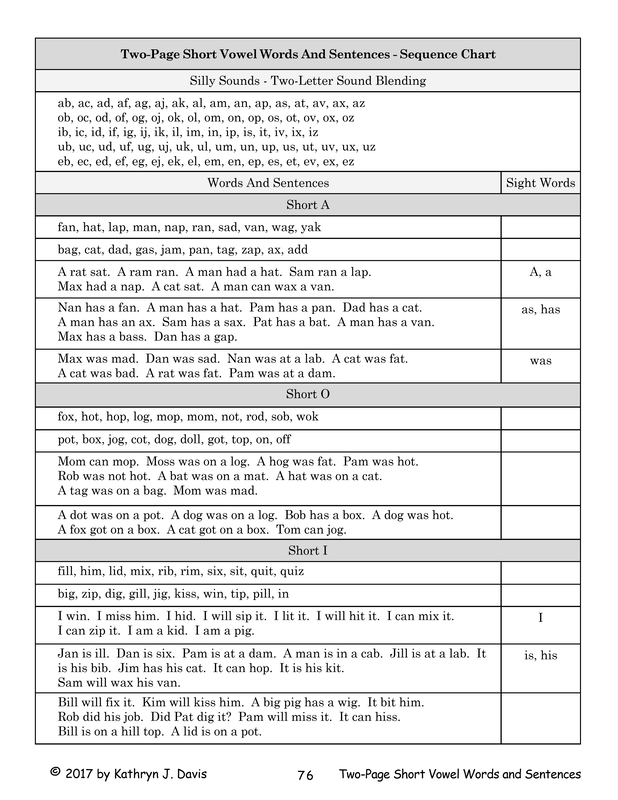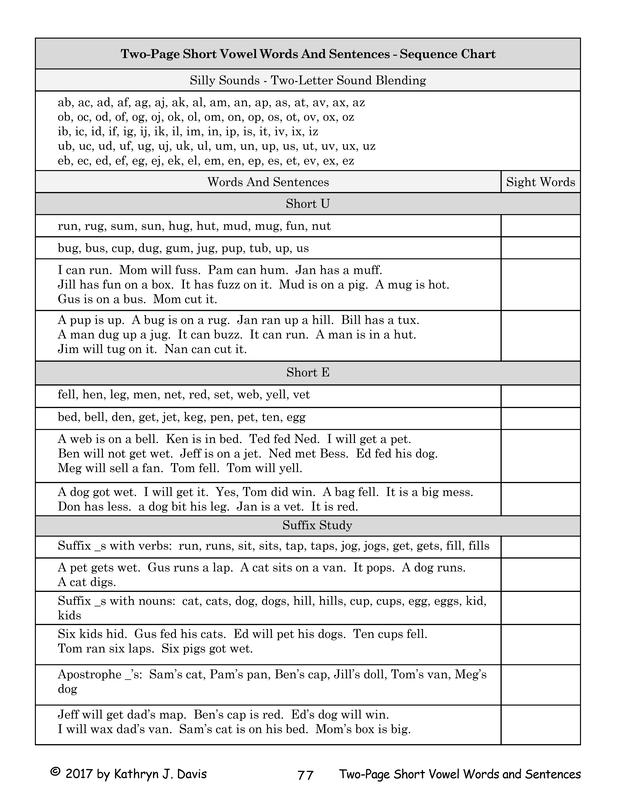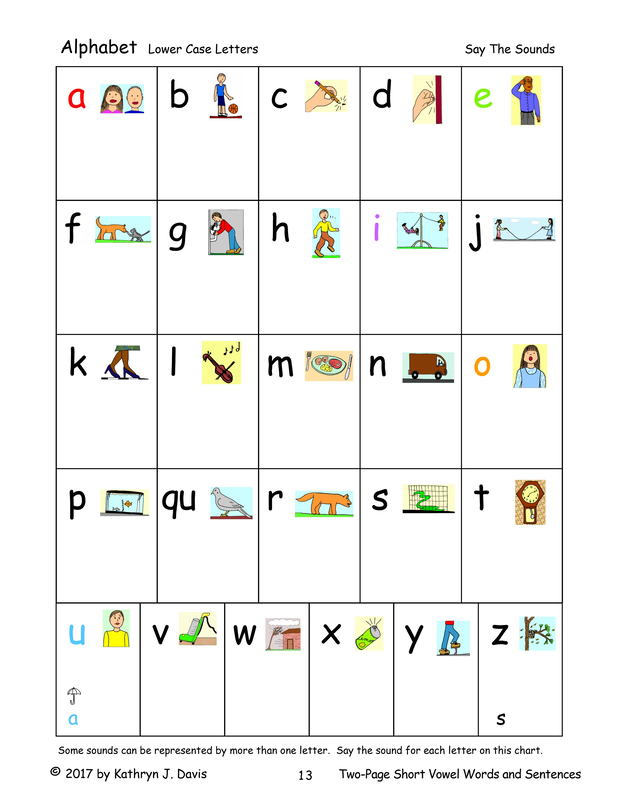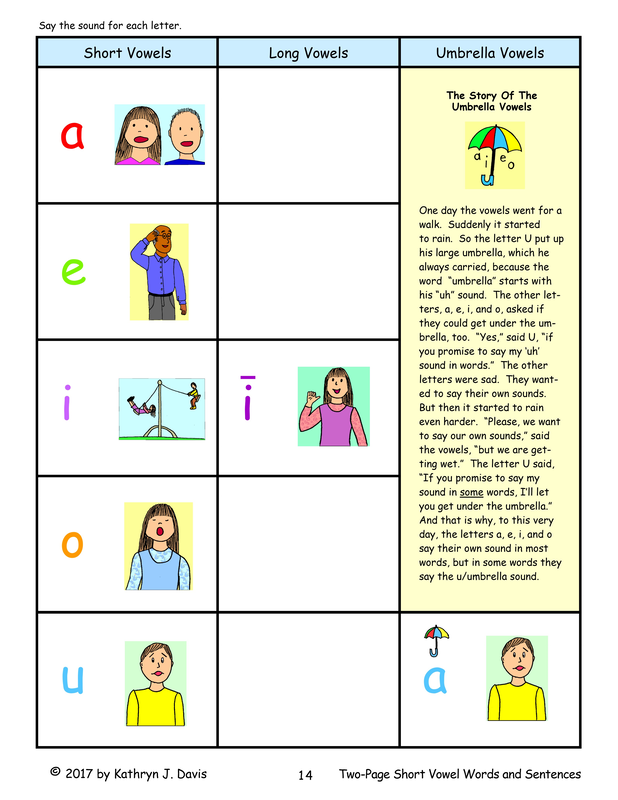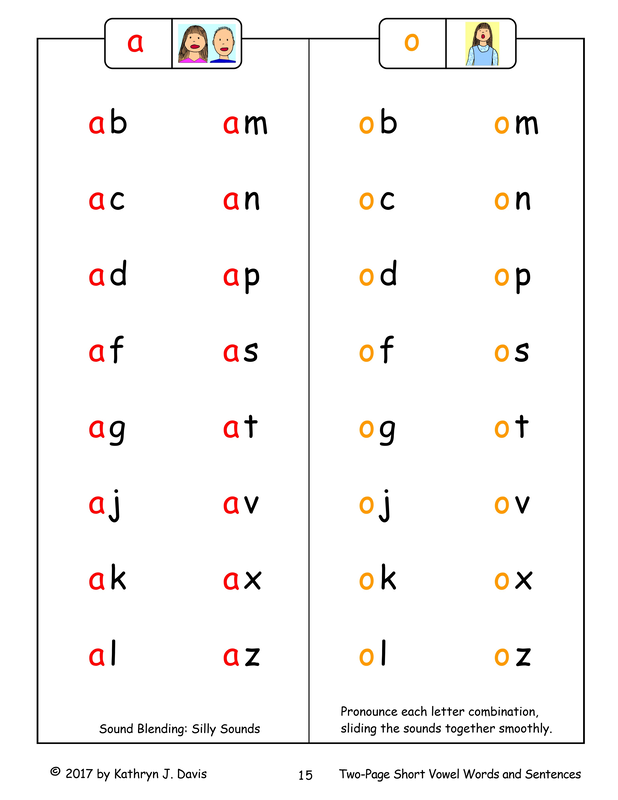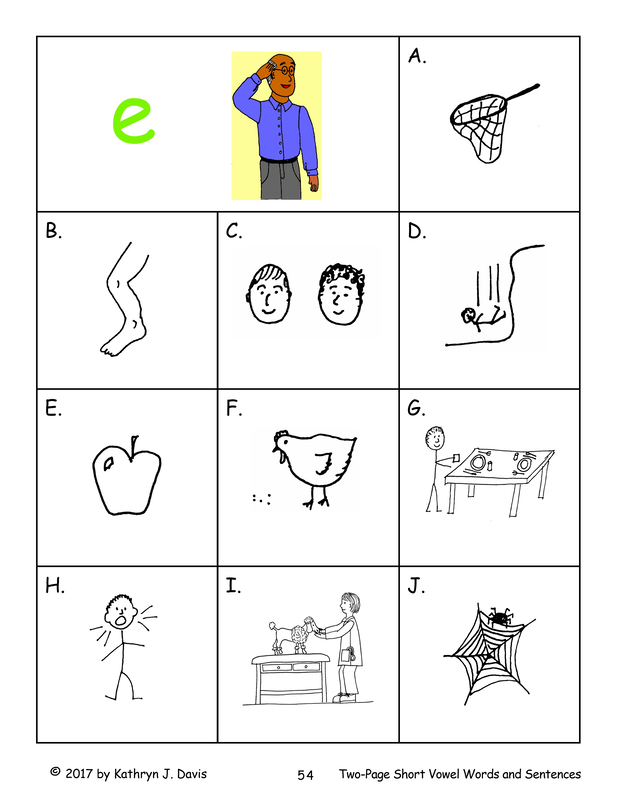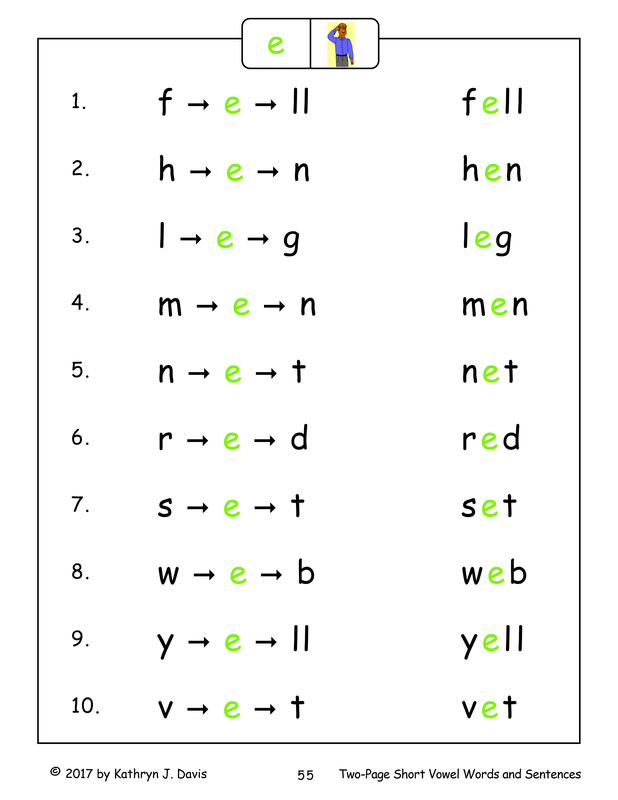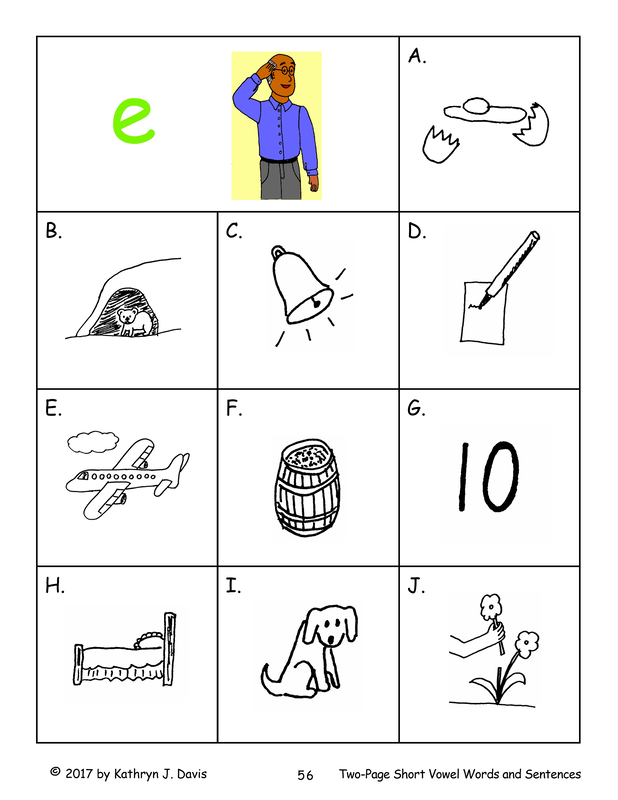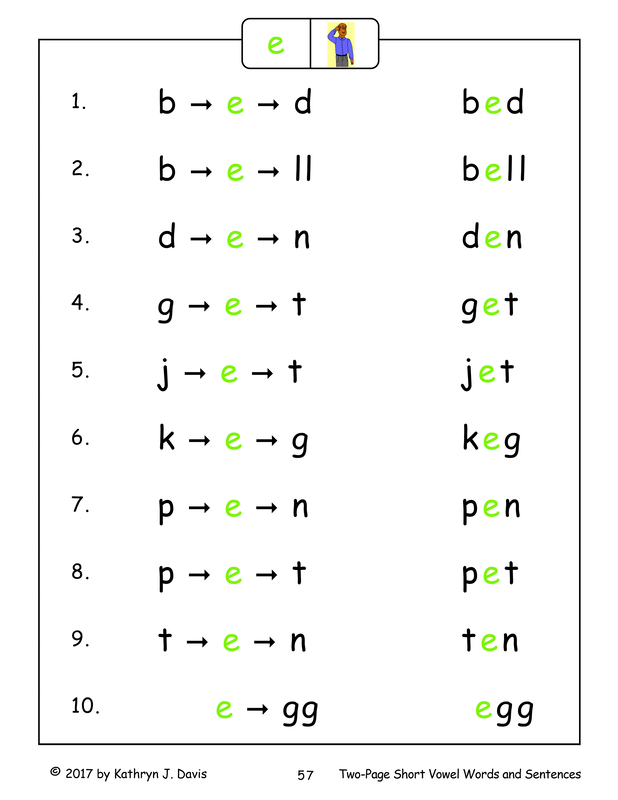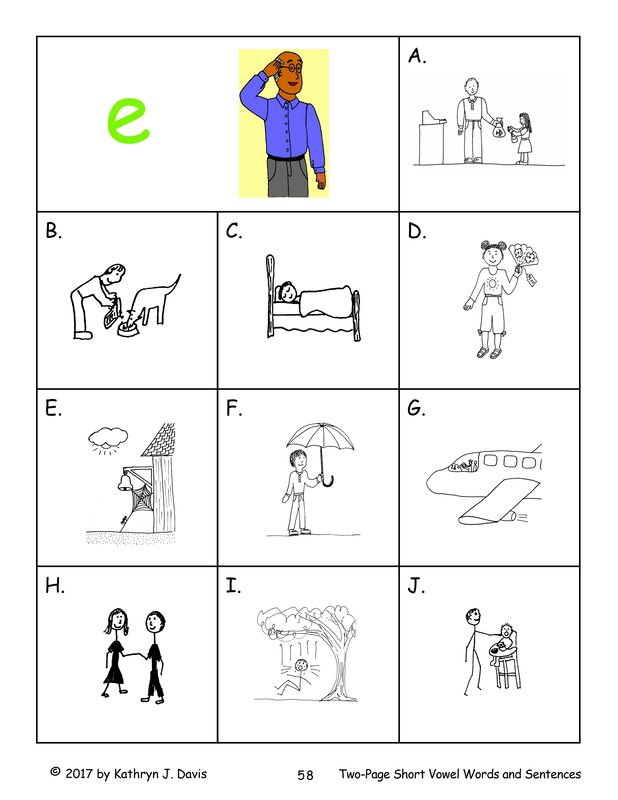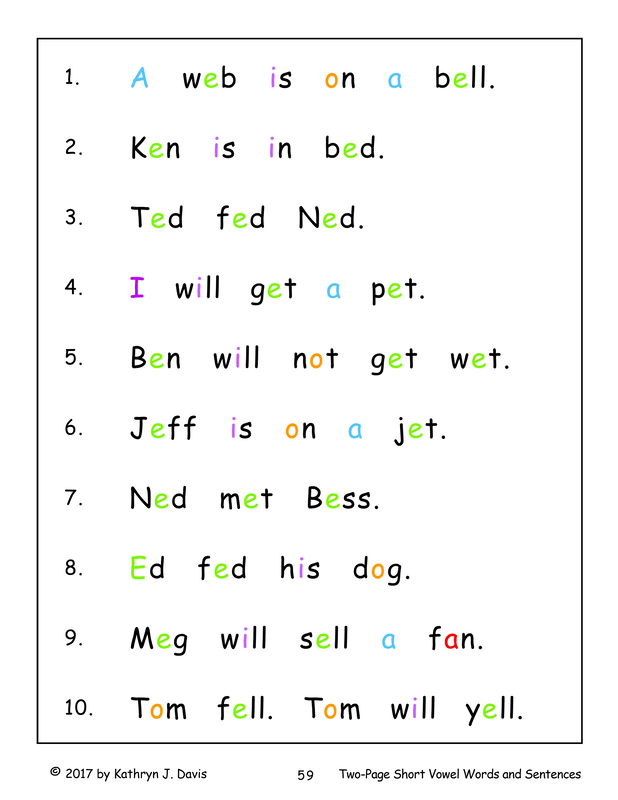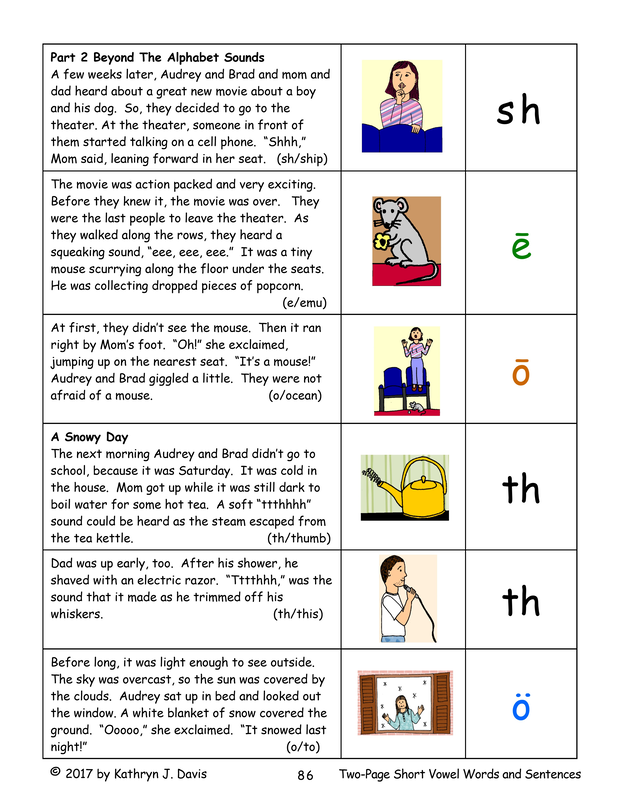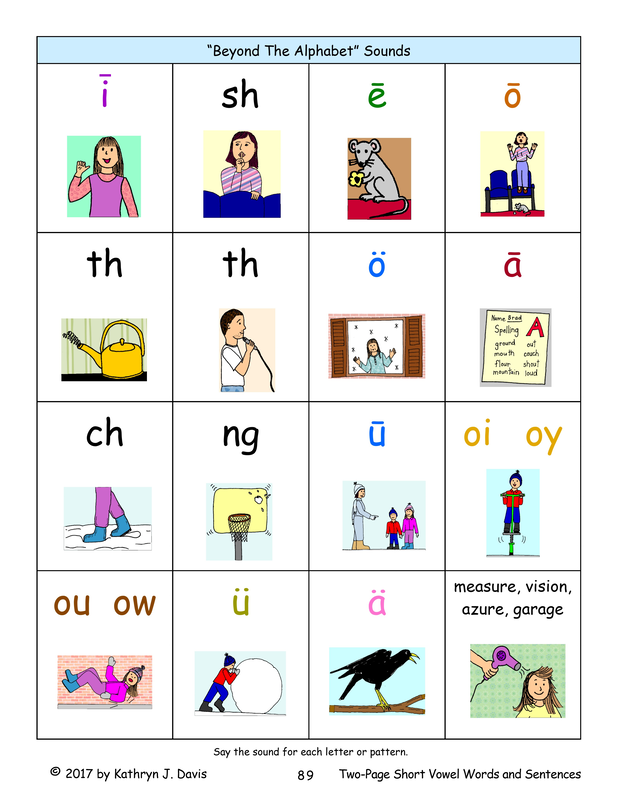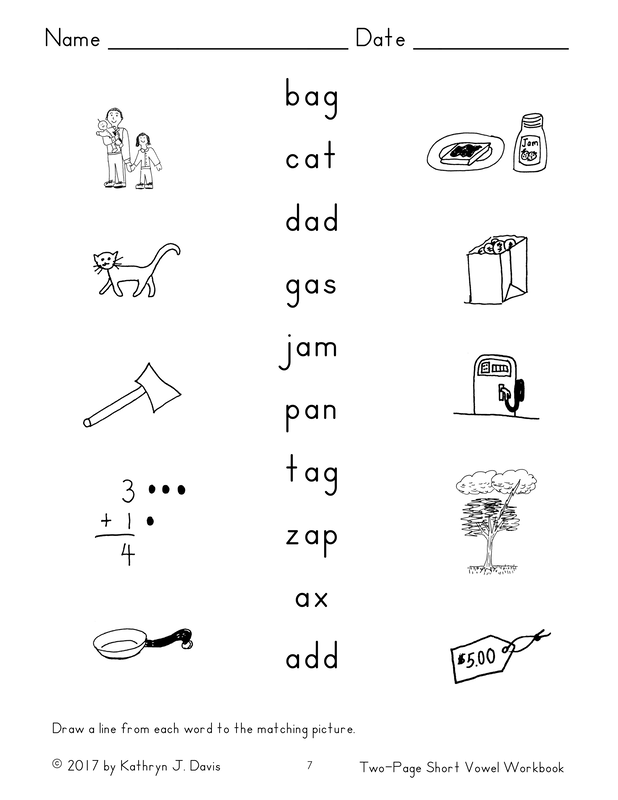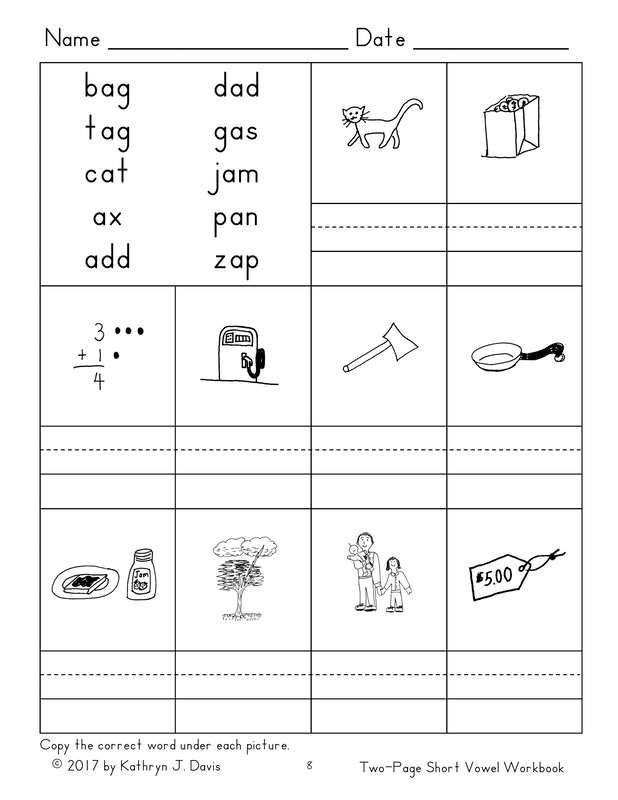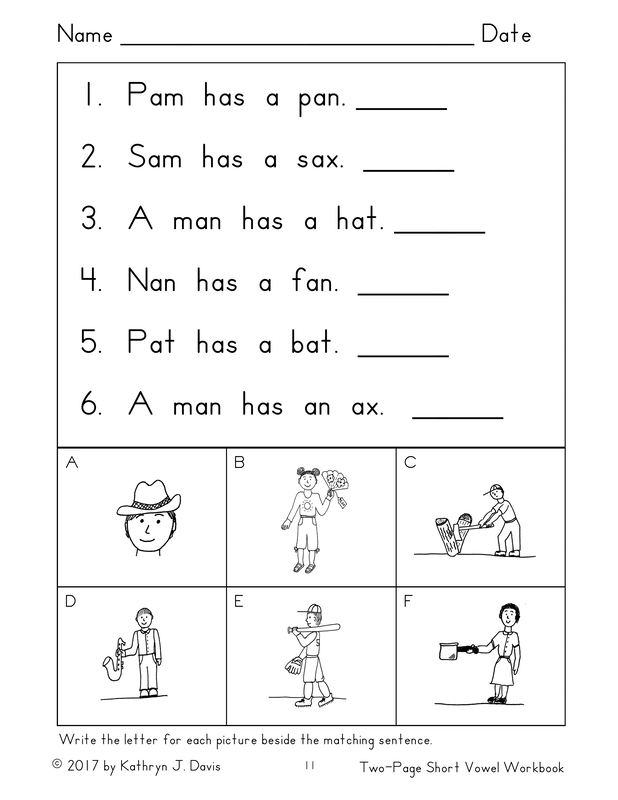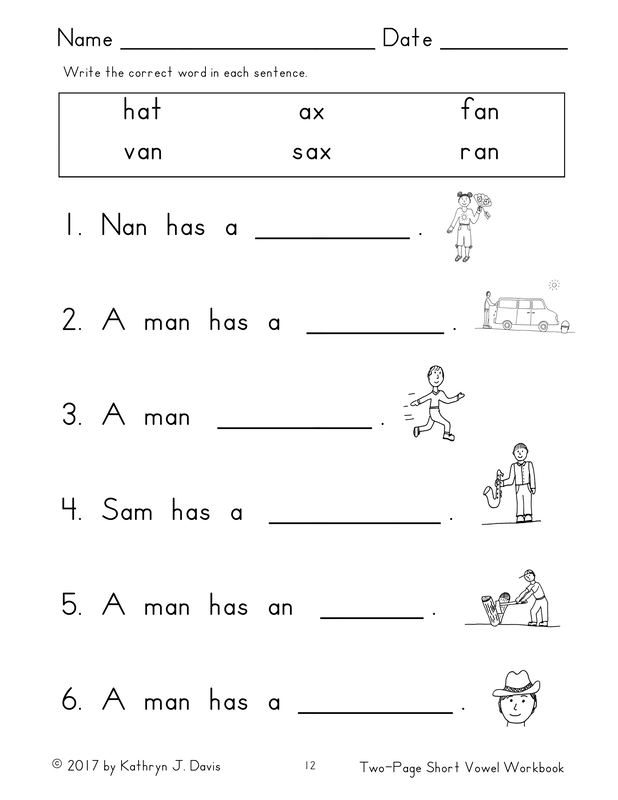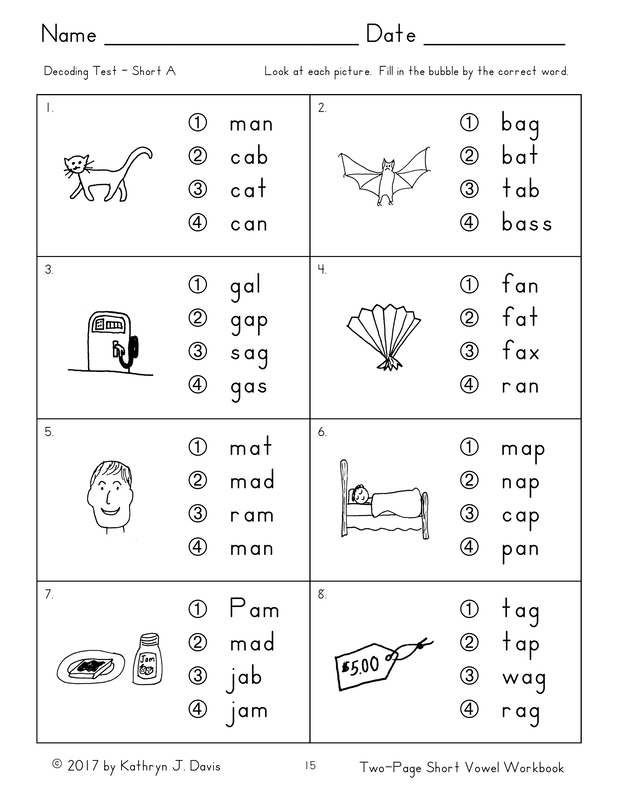If you can't see the main menu at the top of the page, you can click any of the main menu headings here:
A Sequential Phonics Program - Program Overview - PDF Files - Pictures - Audio - Video - Reading Street - Blog.
A Sequential Phonics Program - Program Overview - PDF Files - Pictures - Audio - Video - Reading Street - Blog.
Information About Level 3 - Short Vowel Words And Sentences
This section explains the skills taught in the Level 3 materials. To see the PDF files for these materials, hover over PDF FILES on the main menu and then click on LEVEL 3 - SHORT VOWELS PDFS.
General Comments
- This program has a variety of materials to teach short vowel words because learning to read short vowel words is a large leap compared to learning the letters and their sounds. There are several different short vowel books available. The parent or teacher can pick the book or books that best fit the student or the class. Some of the books have many lessons. These books are suitable for beginners who need lots of practice. Other books have fewer lessons. These can be used to review short vowel words at the beginning of a new school year with students who have already studied them.
- At the short vowel level, students focus on reading and spelling short vowel words only, with the exception of seven sight words (a, as, has, was, is, his, I) that are introduced so that it is possible to begin reading sentences. This gives students time to practice their new spelling and reading skills with words that are short and highly regular phonetically until they gain fluency and confidence.
- Some of the short vowel books have color-coded vowels. Each vowel is printed in a specific color as shown: cat, egg, in, top, fun. The color coding works in several different ways. 1) The color makes the vowels stand out in words. Students will easily be able to differentiate between the vowels and consonants. 2) Students will be able to see at a glance if a list of words all have the same short vowel sound. 3) If two words have different colored vowels, it will be obvious that the vowel sounds are different. 3) It will be easy to see if the vowel comes in the middle of a word, between two consonants, as in the word mud, or at the beginning, as in the word up. 4) Double consonants at the end of a short vowel word will stand out, as in will, pass, and buzz. 5) It may be easier for students to connect the letters in short vowel words more easily when the vowels are color-coded. These concepts are not taught specifically by the teacher. Students will develop these skills intuitively as they study the lessons in the color-coded books.
- The Basic Short Vowels book is in a different format. The words are printed in all black print. Students still spell ten words in each lesson, but the word lists that students read have more than ten words. Each word is illustrated with a small picture. One advantage of this book is that the pages are less expensive to print compared to the books with colored print.
- In some ways, the short vowel level is the most important and challenging part of this program. Students must learn to integrate written visual symbols in words with their own speech. This is both a mental and a physical process. They must process written words by looking at the letters from left to right, remembering and pronouncing each letter sound without hesitation, while putting the sounds together smoothly. While doing all of this, students must also connect each word with its meaning.
- To help students integrate visual information (the letters in a word) with speaking when reading short vowel words, the teaching materials include many different short vowel words. Words that begin and end with all of the possible consonant sounds are introduced for each short vowel. In this way, students learn to pronounce all of the possible consonant-vowel and vowel-consonant combinations found in short vowel words. This speech training is an important part of instruction for beginning readers.
- Patient perseverance at level three will prepare students to do well when they begin reading words with phonics patterns in level four. If they have already mastered the connection between letters and speech in short vowel words, they will be able to read words with new phonics patterns and syllable patterns with confidence.
- At level two, students spell short vowel words with plastic letters, working with the teacher in small groups. At level three, students continue to spell words with plastic letters, and they also spell short vowel words during a daily dictation period. Two spell short vowel words, students say each sound in the word, one sound at a time, starting with the beginning sound, and ending with the last sound. This is called segmenting. Students have already practiced segmenting in levels one and two. At level three, students write the alphabet related letters as they say each sound in the word. Students have prepared for this skill during the letter dictation exercises in level two.
- Students do not say the letter names as they spell phonetic words. As described above, they segment the words by saying the letter sounds. Using the letter names can actually block a student's understanding of the phonetic nature of spelling. Saying the letter names is a distraction that make it more difficult for students to analyze the sound sequence in the word. At best, students would have to translate each letter name to its sound mentally as they proceed. However this two-step process makes spelling much more difficult for many students. For some students it can create an insurmountable difficulty. On the other hand, saying the letter sounds is perfectly logical because students already know how to write each letter when given its sound. In addition, saying the sound for each letter demonstrates the pronunciation of the word.
- The spelling process in this program is a multisensory approach in which students: 1) listen to the word with their ears, 2) pronounce each sound vocally, 3) hear themselves say each sound, 4) simultaneously write the letter using muscles in their arm and fingers, and 5) see each letter as they write it. Using many senses at once in this way provides a powerful boost to student learning.
- It is important for students to use correct letter formation when writing as they work through the short vowel level. If students are in kindergarten, they will receive handwriting instruction at levels one and two. If students are in first grade, they should receive explicit handwriting instruction for each alphabet letter during the first few weeks of school. This is important because not all students will master handwriting completely in kindergarten. It is vital for them to have thorough handwriting instruction at the beginning of first grade. In this way, they can "catch up" and be highly successful in first grade, regardless of their success in kindergarten. Other students in the class will certainly benefit as well by strengthening their handwriting skills. You will find that time spent teaching handwriting carefully and methodically at the beginning of first grade will save an enormous amount of time as the year progresses. The advantage of this approach is that students will be able to complete written assignments accurately and efficiently throughout the rest of the school year. The positive effect on students' confidence is another helpful result.
- At the beginning of first grade, either the letter sized, legal sized, or ledger sized manuscript handwriting book can be used for handwriting instruction. You could also use any of the separate level one or two handwriting books if preferred. Directions are included in the books. Note: A new version of the Mixed Short Vowel Workbook is available that contains handwriting pages. If you use this workbook you won't need a separate handwriting book.
- At level three, students continue to practice pronouncing two-letter vowel-consonant and consonant-vowel combinations, as in ab, ac, ad, af, ag, and ba, ca, da, fa, ga. The same short vowel sound is used in all of the letter combinations. This exercise helps students learn to put two letter sounds together smoothly when they pronounce them. Some students have trouble putting three letter sounds together when they are just getting started. Practicing with just two sounds bridges the gap and prepares students to begin reading three-sound words.
- For each new set of short vowel words, students spell the words first, then they read them. This makes it easier for students to read the words, because they have already analyzed the sounds in each word and translated the sounds into the written letters that represent them.
- Two of the short vowel books, Basic Short Vowels and Color-Coded Short Vowel Lists, have both rhyming and body-coda lists of short vowel words. Body-coda lists have words that begin with the same letters, as in cap, can, cat, cab. Reading both types of lists is especially helpful for students who are having trouble "gluing the sounds together" when they pronounce short vowel words.
- In three of the color-coded short vowel books, the word lists and pictures are arranged so the the teacher can play a "robot game" with the students. The robot game consists of oral blending exercises with both the pictures and the words. Completing this activity with the teacher prepares the students to read the words with confidence. The robot game works well with all of the students, but it is especially helpful with students who have not yet mastered decoding skills (reading words phonetically).
- As they study short a words and short i words, students will learn six sight words (as, has, a, was, is, his, I). This allows them to begin reading and writing simple sentences with short vowel words.
- At level three, students learn to read and spell words with the suffix _s used after nouns and verbs. They also learn how to read and spell words that end with apostrophe 's, as in the cat's mat, mom's pan, and Bob's box.
- The teacher continues to read aloud to the students from appropriate children's books daily. The teacher and the students take time to discuss what is happening in the book as the teacher reads aloud. This builds the students' vocabulary and listening comprehension skills, preparing them to read books on their own.
- (Optional Enrichment At Level Three) In the second half of the kindergarten year students may listen to part two of the sound story read aloud by the teacher, if desired. Part two teaches the "beyond the alphabet sounds" - the remaining fifteen sounds in the English language, including sh/ship, ch/chicken, ē/we, ō/go, ö/to, ä/all, and ü/bush. Students will learn these sounds in the same way that they originally learned the alphabet, using sound picture cards and letter cards. They won't begin reading words with these patterns until level four.
How Does Level Three Fit Into The Overall Sound City Reading Program?
The step chart on the right and the flow charts below show the five teaching levels in the Sound City Reading program. The short vowel level is at the midpoint of the overall program. The blue sections list the books used at the short vowel level. Scroll down to read more about the contents of each book. Click on any of the charts to enlarge them.
|
Level 1 - Red - Learning The Alphabet (Readiness)
Level 2 - Purple - Exploring Sounds In Words (Advanced Readiness) Level 3 - Blue - Short Vowel Words And Sentences Level 4 - Green - Phonetic Words And Stories Level 5 - Golden Yellow - Advanced Phonics Patterns From Children's Books Flow Chart For Levels One Through Five
|
Step Chart For Levels One Through Five
|
Optional Plans For Using Levels Two And Three Together
|
How To Combine Levels 2 And 3 In Kindergarten
In kindergarten, it is possible to combine the level two and level three instruction if desired. This approach is optional. Follow the instructions below.
Students will study new letters and skills as they work through the two Exploring Sounds In Words books. As soon as students have studied enough letters, they will be able to study the first word list in the Rhyming Short Vowel Words And Sentences book. Before going on to the next list, students will continue in the Exploring Sounds In Words book to study any letters needed for that list.
Continue in the same way until all of the letters have been introduced. Then complete the word lists in the short vowel book as usual. The chart below shows the specific letters to study before introducing each list in the Rhyming Short Vowel Words And Sentences book. Click on the chart to enlarge it.
|
How To Combine Levels 2 And 3 In First Grade
In first grade, students will begin the school year with a handwriting review of all of the alphabet letters, studying one new capital and lowercase letter per day. There are two possible ways to do this.
|
What Skills Are Taught At Level Three?
At the short vowel level students develop the following skills.
- They learn to spell and read short vowel words.
- They learn the sight words a, A, as, has, was, is, his, and I.
- They read simple sentences that contain these sight words along with short vowel words.
- They study the suffix _s with nouns and verbs, and the suffix _'s to show ownership.
- (Optional) After students are able to spell and read short vowel words with confidence, they may listen to part two of the sound story and learn the "Beyond The Alphabet" patterns including single long vowels, dotted vowels, and consonant digraphs. They will practice writing the new patterns and saying their sounds, but they do not yet read words with the patterns. This is a limited introduction/preview of some of the patterns that will be taught at level four.
Things To Know About Teaching Short Vowel Words
Level three is a crucial level. Students begin reading and spelling real words. Mastery of this level lays the groundwork for teaching words with phonics patterns at levels four and five.
When students begin reading and spelling words there are two important concepts they must master.
Spelling - Students will listen to a spoken word, analyze the sounds in the word, and pronounce one sound at a time, from first to last, while writing the letter symbols that represent those sounds, going from left to right. In other words, students "segment" the word by breaking it down into its individual sounds as they write it. Notice that students say the sounds when spelling words, not the letter names.
Reading - Students learn to read words by saying the sound for each letter, going from left to right, sliding the sounds together smoothly so that they recognize the spoken word. Putting sounds together to form a word is called "oral blending." The whole process, starting with looking at the letters and saying their sounds, is called "decoding." Decoding words is easier for students if they have already analyzed the sounds in the words by segmenting and spelling them first.
In the Sound City Reading program, spelling and decoding is relatively easy to teach at level three because students have already done oral blending and segmenting exercises throughout levels one and two. They have also had much practice saying the letter sounds when they see them and writing the letter sounds when they hear them. At level three, students combine all of these skills to read and spell short vowel words.
A few irregular sight words are taught at level three (a, A, was, as, has, is, his, I) so that students can begin reading simple short vowel sentences.
Short vowel words are taught before words with the various phonics pattern for several reasons. Note: Short vowel words that begin or end with consonant blends are not taught until level four.
- Short vowel words are more regular than other types of words. In most short vowel words, the letters represent their usual sounds.
- They are also shorter than many words. Many short vowel words are are made up of just two or three-letters, which is helpful for students who are learning to read for the first time.
- There are many short vowel words to study. This provides a lot of practice while maintaining student interest. It also makes it easy to create meaningful sentences for students to read.
- Many of the short vowel words (77 of them) are on the list of the most common one thousand words in English.
However, even three-letter short vowel words can be a challenge for students who are learning to read. Beginners may find it difficult to put three letter sounds together smoothly to pronounce words. As a transition step, two-letter sound blending activities are included in the Exploring Sounds In Words books at level two and in all of the short vowel books at level three. Students practice pronouncing two-sound chunks such as ab, ac, ad, af, and ba, ca, da, fa, with help from the teacher. Because these letter combinations are not real words, we call them "silly sounds." They are meaningless. Combining just two sounds helps students get ready to pronounce three-sound words. In my experience, this preparatory activity has opened the door to decoding short vowel words (and words in general) for many students.
Looking Ahead
It is important for students to master segmenting and decoding skills at this level before going on to the next level, which teaches the phonogram sounds like sh, ai, ow, and ar. Once students can read and write short vowel words comfortably, it will be much easier to add new phonogram patterns, since the segmenting and decoding process remains the same. To read new words, students only need to substitute the new sound symbols that they are learning, usually in the form of consonant digraphs (sh, th, ch), consonant blends (st, fl, gr), and vowel teams (au, oi, ea). Mastering short vowel words also prepares students to begin reading multi-syllable words such as pup-pet and fan-tas-tic.
It is important for students to master segmenting and decoding skills at this level before going on to the next level, which teaches the phonogram sounds like sh, ai, ow, and ar. Once students can read and write short vowel words comfortably, it will be much easier to add new phonogram patterns, since the segmenting and decoding process remains the same. To read new words, students only need to substitute the new sound symbols that they are learning, usually in the form of consonant digraphs (sh, th, ch), consonant blends (st, fl, gr), and vowel teams (au, oi, ea). Mastering short vowel words also prepares students to begin reading multi-syllable words such as pup-pet and fan-tas-tic.
Who Should Use Level Three?
1) Students who have completed level two successfully will be ready to begin level three.
2) If students have completed level one and they are able to successfully complete the first ten lessons at level two, it is possible to combine the instruction for level two with level three from that point on, if desired. This approach, described above in the section with the flow charts, is optional. Use the sequence chart in the selected short vowel book as a guide.
3) If students have not been in the Sound City Reading program, they should be able to begin level three if they can do the following.
- Recognize the upper and lower case letters reliably and give their sounds.
- Write any letters that have been introduced in the initial handwriting lessons with good letter formation.
- Write the letters that have been introduced on lined paper when given the letter sounds.
- Successfully complete three-sound oral blending and segmenting exercises. These exercises are included in the level one and level two books, and they can also be found in the Phonemic Awareness Picture Pages book.
|
Overview Of The Level Three Books
|
Teaching Guides
|
|
There are four main books available at the short vowel level. Generally speaking, students will use just one of the books for reading lessons and will also use the matching workbook. It is not necessary to use all of them.
Three of the books have color-coded vowels. The lessons in these books reinforce phonemic awareness and decoding skills. The fourth book, Basic Short Vowels, has all black print. It's pages are set up in a completely different format. Any of these books will work with beginning readers and also with older students who need extra practice or review to help them read and spell short vowel words.
Each book includes a sequence chart, lesson outline, and other information for the teacher.
Although suggestions are made below about when to use each book, teachers should choose the book that they think is best suited for their student or their class.
All of the books introduce the suffix _s with verbs and nouns and _'s to show ownership. These pages are exactly the same in all of the book and workbooks.
Two pages are included in each short vowel book to introduce syllable awareness. The same two pages are included in every book.
All of the short vowel books include instructions about how to introduce part two of the sound story after students have completed the short vowel instruction. Students listen to part two of the sound story read aloud. They match picture cards from part two of the sound story with "beyond the alphabet" letter cards in a pocket chart. If desired, they may spell words with part two patterns with plastic letters and on paper. The part two introduction is optional at level three.
A separate workbook is available for each of the three color-coded short vowel books. The Rhyming Short Vowel Workbook can be used with the Basic Short Vowels book.
|
The 2017 Rhyming Short Vowel Teaching Guide contains extensive instructions about how to teach the short vowel level.
The Two-Page Short Vowel Words And Sentences book also includes extended instructions for the teacher that will be a helpful guide for teaching short vowels words at any level.
|
|
The Rhyming Short Vowel Words And Sentences book is designed for kindergarten. It begins with short u word lists that can be taught while working through the Exploring Sounds In Words book, if desired. Students then study short a words, short o words, short i words, and short e words. This is the easiest of the short vowel books. All of the words on each word list have the same short vowel sound. All of the word lists for each short vowel are taught one after the other before going on to the next short vowel. All of the words on the sentence pages are introduced in one of the word lists first. Many words are taught, so that students can learn to combine all possible beginning and ending consonant sounds with each short vowel. This gives students a lot of practice integrating written text with speech.
|
The Mixed Short Vowel Words And Sentences book is designed for the beginning of first grade. It provides a faster approach than the Rhyming Short Vowel book. It introduces the wordlists in a sequence that matches the beginning of the year handwriting review. Some of the word lists in this book have the same same vowel in all of the words. Other words lists contain two different short vowels. This is why it is called Mixed Short Vowel Words And Sentences. Two versions of the Mixed Short Vowel Workbook are available. The first version includes short vowel discrimination pages after the mixed short vowel word lists and sentence pages. In the second version, there are no discrimination pages, but handwriting introduction pages have been included.
|
The Two-Page Short Vowel Words And Sentences book works best at the beginning of second grade. It is the shortest version of the three color-coded short vowel books, with only two pages of words for each short vowel. The first page for each vowel introduces words that begin with continuous consonants that can be held indefinitely when you pronounce them: f, l, m, n, r, s, v, w, y, and z. The second page for each short vowel introduces words that begin with stop consonants that cannot be held: b, c, d, g, j, k, p, and t. Sentence pages are included. This book provides a quick review of short vowel words. Beginning students will find it more difficult than the other short vowel books. Because there are only twenty words on the word lists that introduce each short vowel, students will see many short vowel words in the sentences that have not been introduced. Students will need to be able to decode these words and they may need help to understand their meanings.
Extended instructions for the teacher are included at the end of this book. These pages will be helpful when teaching any of the short vowel books at any level.
|
The Basic Short Vowels book is printed in all black print. It has a completely different page format when compared to the three color-coded short vowel books. The words and pictures are beside each other, on the same page. The word lists are not limited to ten words. The first part of the book introduces short u words while students are learning to write the letters of the alphabet. After that, it introduces short a words, short o words, short i words, and short e words. This matches the order in the Rhyming Short Vowel Words And Sentences Book. For each short vowel, the words are presented first in rhyming lists and then again in body-coda lists (pan, pat, pal). This helps students develop fluency when reading short vowel words.
You can use the Rhyming Short Vowel Workbook with the Basic Short Vowels book.
|
Playing The "Robot Game" In The Color-Coded Short Vowel Books
|
The color-coded short vowel books listed above are set up with short vowel words on the right page and the related pictures on the left page. The words and pictures are arranged in a different order. Using these pages, the teacher plays a "Robot Game" with the students to develop an awareness of the separate sounds in the words. The teacher says the sounds for each picture "like a robot," pausing between each sound in the word. (I developed this idea many years ago when robots actually spoke in a halting manner.) The students must listen carefully to the sounds and put them together mentally to form a word. This skill is called oral blending. Students then find the picture for that word.
|
|
Typically, oral blending activities are done orally, without the use of words or letters. In the robot game, the teacher first does the oral blending exercise with the set of pictures, and then does the oral blending exercise with the words in the first column. In the first column, arrows separate the individual letters, making it easy for students to decode (sound out) the word going from left to right. Finally, students read the same words going down the second column. In the second column, students read the same words without arrows.
|
The books with color-coded vowels introduce ten new words in each lesson. The words are placed on the right hand page of the book, and the matching pictures are placed on the left hand page. The pictures are not in the same order as the words. This allows the teacher and the students to play a "robot game." First the teacher segments the sounds for each word "like a robot" (says each sound individually, with a slight pause in between each sound). For each word, students put the sounds together mentally and find the matching picture. Next, the teacher segments the sounds for the pictures. This time students listen to the sounds for each picture and find the matching word. Last, students read each new word going down and back up the column.
Because the Basic Short Vowels book is printed in a completely different format, it is not possible to play the robot game in it. However, it's possible to play the robot game in the workbook. See the instructions at the end of the two Phonics Patterns Workbooks. The instructions can be applied to any of the short vowel workbooks.
Syllable Study Pages
These are the syllable study pages included in the level three books. They are oral exercises. The students do not read words - they just look at the pictures. Pages with the same format but different pictures are also included in each of the level four books.
Additional Books Used To Teach Short Vowel Words
The books shown below can be used as a supplement to any of the books listed above.
Color-Coded Short Vowel Lists
|
This book has color-coded vowels. Each short vowel is printed in a specific color. The fact that the vowels are printed in color creates a clear delineation between the consonants and vowels.
The book helps students build fluency when reading short vowel words. It is ideal to use after students have learned all of the letters of the alphabet.
It contains rhyming words lists followed by body-coda lists (same beginning sound) for each short vowel. Students simply read the word lists for each section. As they read, they will combine all of the possible beginning and ending consonant sounds with the short vowel sound. This is in essence a decoding exercise combined with a speech lesson.
Reading these lists helps students internalize the decoding process so that they don't have to stop and think about how to "sound out" each word. With practice, they will be able to read short vowel words fluently.
|
I have added wordlists that have short vowel words with beginning and ending consonant blends to the end of this book. They can be studied as a challenge level after completing level 3, or they can be used for extra practice when studying the beginning and ending consonant blends in book one at level 4.
I've also added short wordlists for each pattern introduced in part two of the sound story. These are words with the "beyond the alphabet" sounds, including sh/ship, ē/he, ō/go, th/thumb, th/this, etc.
|
Sample pages from Color-Coded Short Vowel Lists
|
Click any page to enlarge it.
|
Optional pages to introduce short vowel words with consonant blends.
Optional pages to introduce patterns from part two of the sound story.
Short Vowel Booklets
|
|
Click on either page to enlarge it.
|
The print format is similar to the Basic Short Vowels book. Each booklet focuses on a single short vowel. These are the first phonics books that I created for my first grade students in Johnson City. I had moved up from kindergarten to first grade and needed something to provide an easy short vowel review for the students.
The ten Short Vowel Booklets can be used for extra practice reading short vowel words. Students love these small 5 1/2 by 4 1/4 inch booklets. The print is large and the pages are small, so students only have to focus on a few words at a time. The words are presented in rhyming lists, making it easy for students to read the words. Each booklet focuses on words for a specific short vowel. Students read each group of words, then turn the page to see and read the same words with pictures. Students also read easy, illustrated sentences.
There are ten separate booklets. The words and sentences are illustrated. The booklets have all black print.
An introductory book (Book 0) teaches short u words while students are learning the alphabet. The remaining booklets teach short vowels in this order: two short a books, two short o books, three short i books, one short u book, and one short e book.
The Short Vowel Booklets can be used alone or as extra practice when using any of the books listed above.
My students loved these little booklets. They laughed uproariously at my stick figure pictures, because they "didn't have any clothes on." I learned to add clothing to the figures, although I didn't have time to fix all of them. At the time I was teaching full time and taking night classes towards my master's degree. Whatever I did to create these booklets had to be done quickly. One year the parent of one of my students asked to buy a set of the booklets for a Christmas present for their son. They were the number one item on his list.
These are the covers for the short vowel booklets.
Know The Phonetic Code - Volume 1
The Know The Phonetic Code books are used at level four to teach words with the common phonics patterns. However, the first volume begins with short vowel words and sentences. The words are arranged in rhyming and body coda (same beginning sound) lists. This allows the flexibility to cover both levels three and four with the Know The Phonetic Code books when working with students. Click to enlarge any of the sample pages below.
Other Materials To Use At Level 3
|
Books
Manuscript Handwriting On Letter Sized Paper Manuscript Handwriting On Legal Paper Manuscript Handwriting On Ledger Paper A Sound Story About Audrey And Brad Phonemic Awareness Picture Pages Cards
Alphabet Cards - Capital And Lower Case Beyond The Alphabet Cards (Optional at level three) Sound Picture Cards Parts 1 And 2 (Part 2 is optional at level three) |
Learning Games
Apple Alphabet Game Apple Concentration Game Raspberry Game Blueberry Game Letter Connection Cards Short Vowel Picture-Word Lotto Train Game (Optional at level three, With Sound Story Part 2 Sounds) Wall Charts
Alphabet Chart Level 3 Vowel Chart Beyond The Alphabet Chart (Optional at level three, With Sound Story Part 2 Sounds) |
Extended Information About Books Used At Level 3
Rhyming Short Vowel Words And Sentences
|
This is the easiest short vowel book for beginning readers. It is a good book to use in kindergarten.
This book originally started with short a words. However, the letter a is one of the more difficult letters to write - the letter u is much easier, and it is introduced much earlier in the handwriting sequence. I discovered that it is just as easy for students to hear the short u sound in words and use it when spelling words, so I revised the book to start with short u words. This allows students to begin writing short vowel words as soon as students have learned to write the letter u. Note: The letter i is the easiest vowel to write - it is the first vowel introduced in the handwriting sequence. However, it is difficult for beginning students to hear the short i sound in words.
The words in this book are presented in rhyming lists, one vowel at a time, beginning with short u words, followed by short a, short o, short i, and short e words. Each short vowel is printed in a specific color so that the vowels will stand out in words and give an indication of the correct vowel sound. Multiple lists for each short vowel provide plenty of practice for beginners. The order of introduction is carefully designed. It is relatively easy for young students to hear the short u, a, and o sounds in words. It is harder for students to hear the short i and e sounds in words. Short e words are the most difficult and are saved for last.
|
The pages with word lists are set up with words on the right side and pictures on the left side. This allows the teacher to do an activity called the "Robot Game" with each set of pictures and words. The oral analysis of the individual sounds in the words that occurs during this game prepares students to read and spell them.
Students learn a few sight words (A, a, was, as, has, is, his, I) as they work through the lessons. This enables them to begin reading and writing simple short vowel sentences.
Spelling the words is an important part of the learning process. Sometimes its hard for students to catch on to reading short vowel words. It helps if they practice spelling new words before they attempt to read them. Students practice spelling words with plastic letters and spell them on paper as well. Students spell short vowel words by listening to the word pronounced by the teacher and saying each sound in the word, one at a time, while simultaneously writing the related letters.
Pages are included at the end of the book that explain how to introduce the letters and letter patterns from part two of the sound story, if desired. The workbook includes pages to introduce the patterns in part two of the sound story. The part two instruction is optional at level three. Scroll down to see sample pages.
|
Rhyming Short Vowel Words And Sentences - Lesson Outline
|
Click to enlarge either page.
|
|
Rhyming Short Vowel Words And Sentences - Sequence Chart
|
Click to enlarge any page.
|
|
Rhyming Short Vowel Words And Sentences - Sample Pages
|
Click to enlarge any page.
|
Students study these picture/word pages using a three step process. The first two steps are called the "robot game" because the teacher speaks "like a robot."
- Students hear the the teacher pronounce the individual letter sounds for the words in the first column, find the matching pictures, and pronounce the word normally.
- Students hear the teacher pronounce the individual letter sounds for each of the pictures, find the matching words in the first column, and pronounce the word normally.
- Students read the words in the second column, going down and back up the column.
After studying the words in this way with the whole class, students take turns reading the same words for the teacher during small group rotations. If a student gets stuck reading a word in the second column, he looks at the same word in the second column. He points to the first letter, says its sound, slides to the right, following the arrow, says the next sound, slides to the right again, and says the last sound. Then he moves to the same word in the right column, and says the word normally, without pausing between the sounds.
1) The teacher introduces the sight words featured on the picture pages below. 2) Students read each sentence and find the matching picture.
Optional pages to introduce patterns from part two of the sound story.
Rhyming Short Vowel Workbook - Sample Pages
Optional workbook pages that can be used to introduce patterns from part two of the sound story.
Basic Short Vowels
|
This book is printed in all black print. All of the short vowel words are illustrated. The word lists are not limited to ten words. This book can be used with beginners or students who are reviewing short vowel words after studying them previously. It would work well in kindergarten or first grade. It can be used with older students who need to begin with short vowel words. It could also be used for extra practice with students who are working in any of the color-coded books listed above.
Students read both rhyming word lists (cat, rat, bat, sat) and body-coda word lists (cat, cap, can, cab) in this book. This is very helpful for some students. It helps them develop fluency when decoding short vowel words. They only need to focus on changing the beginning sound or ending sound when they read each word list.
After learning a few basic sight words (a, as, has, was, is, his, I) students begin reading simple short vowel sentences. The sentences are illustrated.
The Basic Short Vowels book follows the same short vowel sequence as the Rhyming Short Vowel Words And Sentences book. It could be used as a companion to that book to provide extra practice. You can use the Rhyming Short Vowel Workbook with the Basic Short Vowels book.
|
All of the short vowel books have an optional section at the end that can be used to introduce the letters and letter patterns from part two of the sound story. The Basic Short Vowels book has that option, and it also has an additional section that is not included in the other short vowel books. Students can begin reading words with most of the part-two patterns, including the sh, th, ng, oi, oy, ou, and ow patterns. For the long vowel sounds, illustrated word lists are used to model the long sounds at the beginning of words. Students are not expected to read those words. The teacher pronounces the words to demonstrate the beginning long vowel sounds. See the sample pages below.
Basic Short Vowels - Lesson Outline
Basic Short Vowels - Sequence Chart
Basic Short Vowels - Sample Pages
Optional pages to introduce patterns from part two of the sound story.
Mixed Short Vowel Words And Sentences
|
This book is designed so that students can begin reading and writing words at the beginning of first grade while they are completing handwriting lessons to review letter formation. The lessons are set up so that students can complete handwriting lessons for all of the letters of the alphabet while they are working through the Mixed Short Vowel Words And Sentences book.
Students in first grade need thorough instruction in handwriting and in short vowel words, even if they studied them in kindergarten. However, they cannot afford to wait until all the alphabet letters are introduced in handwriting to start reading and spelling short vowel words. To solve this problem, lists of words to spell and read are selected so that only the handwriting letters that have been taught/reviewed are included. The goal is to start reading and writing from the beginning of the school year while still taking time to solidify short vowel decoding skills and letter formation in handwriting.
|
The Mixed Short Vowel Words And Sentences book has the same format as the Rhyming Short Vowel Words And Sentences book, with large color-coded print. Words and pictures are on facing pages. However in the Rhyming Short Vowel Book, all of the word lists with the same short vowel sound are included in the same section. In the Mixed Short Vowel book, the word lists for each short vowel are not grouped together. They are spread throughout the book.
Each new word list is added as soon as students have learned/reviewed enough letters to write those words. Students may work on a short i list, followed by a short u list, followed by a short e list. Some of the word lists contain words with two different vowels. For example students may study a set of words that has both short u and short e words. The effect of this organization is that students can practice short vowels thoroughly but in a timely manner at the beginning of the school year, and then move on as soon as possible to words with phonics patterns. By the time all of the letters have been introduced during handwriting instruction, teaching one new letter per day, students will be almost at the end of the book.
If desired, students can listen to Part 2 of the sound story as they work through this book. Part 2 introduces the "Beyond The Alphabet" sounds, including consonant digraph sounds (sh, th, ch, ng) and the remaining vowel sounds. If preferred, students can wait until they begin level four to study part two of the story. They will be introduced to those patterns while they are working through book one at level four.
There are two different workbooks that can be used with the Mixed Short Vowel Words And Sentences book. The short vowel word lists and sentence pages are exactly the same in both workbooks. The original workbook does not include handwriting pages but it includes extra word lists at the end to practice short vowel discrimination, for example: pat, pot, cat, cot, cab, cob. A newer workbook version includes handwriting pages and pages to introduce the part two patterns from the sound story, but it does not include the vowel discrimination pages.
Mixed Short Vowel Words And Sentences - Lesson Outline
Mixed Short Vowel Words And Sentences - Sequence Chart
Mixed Short Vowel Words And Sentences - Sample Pages
|
Level 3 Vowel Chart
|
Two-Letter Sound Blending Exercise
|
1) Students hear the individual letter sounds from the first column pronounced by the teacher and find the matching pictures. 2) Students look at the pictures, listen to the teacher pronounce the individual sounds for a specific picture, find the matching word in the first column, and read it. 3) Students read the words in the second column, going down the column and back up again.
Some of the word lists contain words with two different vowel sounds.
Students study new sight words, then read each phrase or sentence and find the matching picture.
Mixed Short Vowel Words And Sentences - Sample Workbook Pages
Optional pages to introduce patterns from part two of the sound story.
Two-Page Short Vowel Words And Sentences
|
The book can be used for a quick review of short vowel words. It will work best with students who have studied short vowel words before, for example, at the beginning of second grade. Some students will come into second grade still needing to strengthen their phonemic awareness, spelling, and decoding skills. This book will provide them with a strong foundation to build on as they continue their learning in second grade.
Students will need to know the letters of the alphabet and their related sounds before starting Two-Page Short Vowel Words And Sentences. Students should also be able to write the letters of the alphabet with good letter formation. The Two-Page Short Vowel Workbook begins with several pages that can be used as quick handwriting review.
The teacher can decide how quickly to move through this book in second grade, depending on how well students have mastered short vowel words in previous years.
Instructions in this book explain how to use the book in first grade with a slower handwriting introduction. While this is possible, the newer Mixed Short Vowel Words And Sentences book will work better in first grade.
|
The words in the Two-Page Short Vowel book are not set up in rhyming lists. There are two sets of words for each short vowel. The first set begins with continuous consonants, that is, consonants like /sssss/ and /mmmm/ that can be held when they are pronounced. This makes it easier to connect the initial consonant sound to the vowel sound when pronouncing the words. The second set begins with stop consonants, that is, consonants that cannot be held, like /c/ and /t/. The sound disappears immediately after it is pronounced. It is harder to read words with stop consonants because it is more difficult to connect the beginning stop consonant sound with the vowel that follows.
The sentences in this book contain many short vowel words that are not included in the two word lists introduced for each short vowel. Students who are able to read short vowel words easily will not need extra help with these words. Students who are still developing their decoding skills will need to preview the extra words before reading the sentences. The teacher should make flashcards to introduce those words. Be sure to explain any unfamiliar words.
Extended instructions for the teacher are included at the end of the Two-Page Short Vowel book, describing activities that will help students be successful when reading and spelling short vowel words and sentences. These pages will be helpful when teaching any of the short vowel books.
Two-Page Short Vowel Words And Sentences - Lesson Outline
These lesson outlines apply to situations where students are learning/reviewing the letters of the alphabet, including handwriting lessons to teach letter formation. However, my current recommendation is to use the Two-Page Short Vowel Words And Sentences book at the beginning of second grade. Begin the lessons after a brief handwriting review period. Read one or two set of words per day, followed by one or more sentence pages.
Two-Page Short Vowel Words And Sentences - Sequence Chart
Two-Page Short Vowel Words And Sentences - Sample Pages
Optional pages to introduce or review patterns from part two of the sound story.
Two-Page Short Vowel Workbook - Sample Pages

